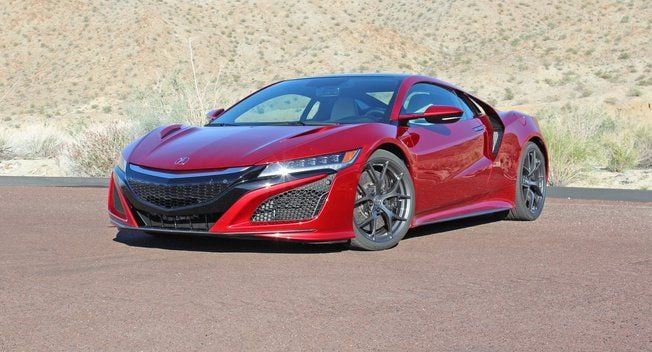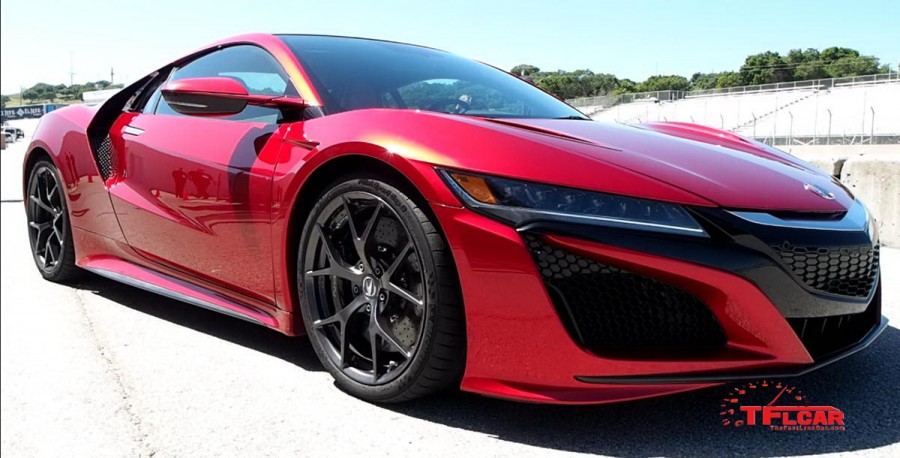2nd Generation Acura NSX Reviews
#41
You'll Never Walk Alone
iTrader: (1)
Join Date: Jun 2005
Location: Vancouver, BC, Canada
Age: 37
Posts: 9,492
Received 834 Likes
on
518 Posts
Just do it, you only live this life once.
Besides, you'll be King of Acurazine if you do. Not that it matters to you, but you would be. I can't even imagine having a RLX Sport Hybrid and a NSX Sport Hybrid in the same driveway right now. Maybe when my son is done with grad school, which I presume I'm paying for too.
I can't even imagine having a RLX Sport Hybrid and a NSX Sport Hybrid in the same driveway right now. Maybe when my son is done with grad school, which I presume I'm paying for too.
Besides, you'll be King of Acurazine if you do. Not that it matters to you, but you would be.
 I can't even imagine having a RLX Sport Hybrid and a NSX Sport Hybrid in the same driveway right now. Maybe when my son is done with grad school, which I presume I'm paying for too.
I can't even imagine having a RLX Sport Hybrid and a NSX Sport Hybrid in the same driveway right now. Maybe when my son is done with grad school, which I presume I'm paying for too.
#42
Grandpa
Join Date: Dec 2003
Location: Virginia, Besieged
Age: 68
Posts: 7,596
Received 2,609 Likes
on
1,475 Posts
You get it or you don't.
#43
Grandpa
Join Date: Dec 2003
Location: Virginia, Besieged
Age: 68
Posts: 7,596
Received 2,609 Likes
on
1,475 Posts
#44
Grandpa
Join Date: Dec 2003
Location: Virginia, Besieged
Age: 68
Posts: 7,596
Received 2,609 Likes
on
1,475 Posts
Just do it, you only live this life once.
Besides, you'll be King of Acurazine if you do. Not that it matters to you, but you would be. I can't even imagine having a RLX Sport Hybrid and a NSX Sport Hybrid in the same driveway right now. Maybe when my son is done with grad school, which I presume I'm paying for too.
I can't even imagine having a RLX Sport Hybrid and a NSX Sport Hybrid in the same driveway right now. Maybe when my son is done with grad school, which I presume I'm paying for too.
Besides, you'll be King of Acurazine if you do. Not that it matters to you, but you would be.
 I can't even imagine having a RLX Sport Hybrid and a NSX Sport Hybrid in the same driveway right now. Maybe when my son is done with grad school, which I presume I'm paying for too.
I can't even imagine having a RLX Sport Hybrid and a NSX Sport Hybrid in the same driveway right now. Maybe when my son is done with grad school, which I presume I'm paying for too.If I did that, I'd disappear, not be the king of anything.
Just to avoid people tracking me down, I'd disappear. LOL.... :-)
I don't see it happening, anyway. It won't make sense.
I'm typing this in a cottage in the country that's probably not worth quite as much as the NSX Sport Hybrid, fully optioned.
#45
Three Wheelin'
Although he came across a bit more critical comparing it to the original NSX, I thought it was a balanced and honest review.
#48
Grandpa
Join Date: Dec 2003
Location: Virginia, Besieged
Age: 68
Posts: 7,596
Received 2,609 Likes
on
1,475 Posts
I'm not sure that playing around with a wheelchair in front of a Zanardi machine is very well thought out. I hope that doesn't come back to bite him in the hind parts.
Regardless, he's not really the kind of person at whom the NSX Sport Hybrid is aimed.
He doesn't really get it. The days of Pininfarina are gone, never to return.
The days of steering "feel" are just gone until we can figure out how to provide an artificial but relevant feel the way that we've done with the brake pedal. The brake pedal isn't connected to anything, either, but the servo pushes back with a good feeling pressure regardless of how much your brake pads are worn.
I've described this before as the kind of feel you've always tried to get on your track car but were never able to achieve.
:-)
The people who buy the NSX Sport Hybrid are going to look at the EPA sticker on it...and this is not something that most reviewers understand.
In the end, his review is not so bad...but he does *not* get it, because he's not the guy at whom the car is aimed, and none of us will be surprised that he does not buy one.
Regardless, he's not really the kind of person at whom the NSX Sport Hybrid is aimed.
He doesn't really get it. The days of Pininfarina are gone, never to return.
The days of steering "feel" are just gone until we can figure out how to provide an artificial but relevant feel the way that we've done with the brake pedal. The brake pedal isn't connected to anything, either, but the servo pushes back with a good feeling pressure regardless of how much your brake pads are worn.
I've described this before as the kind of feel you've always tried to get on your track car but were never able to achieve.
:-)
The people who buy the NSX Sport Hybrid are going to look at the EPA sticker on it...and this is not something that most reviewers understand.
In the end, his review is not so bad...but he does *not* get it, because he's not the guy at whom the car is aimed, and none of us will be surprised that he does not buy one.
The following 2 users liked this post by George Knighton:
Malibu Flyer (12-20-2015),
pgeorg (12-11-2015)
#49
Safety Car
Thread Starter
For nearly a decade the promise of a 2nd-generation Acura NSX has been dangling in front of the automotive world like a juicy carrot hanging from a stick in front of a hungry mule. And just like that mule, we never could quite get to the prize at the end of the rope.
Acura started development of a front-engined NSX powered by a V10 engine in the mid-2000s, but The Great Recession put the kibosh on that plan by the end of 2008. Once the economic outlook improved Acura teased us with a new, mid-engined NSX concept in 2012, but we were forced to wait once again when the company decided that the show car's naturally-aspirated V6 wasn't really supercar worthy.
But finally, the wait is over. The real question is, though, has it been worth it?
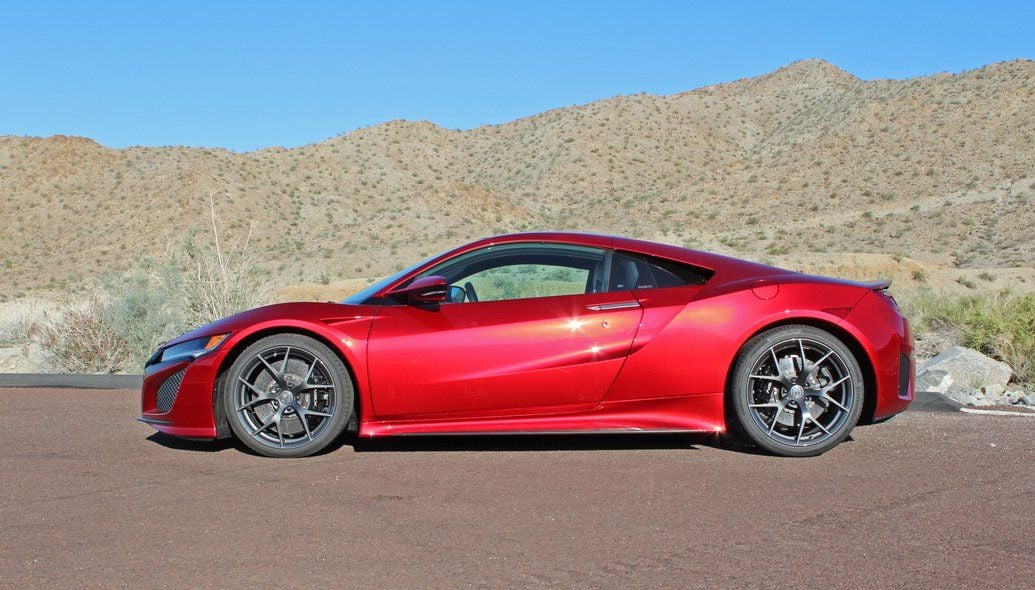
What is it?
Since a lot has changed over the last few years in the world of NSX, it's probably best to start with the basics.
Like the original, the 2017 NSX is a 2-door coupe with seating for 2. The latest version of the NSX also has a V6 engine in the middle, but that's where the similarities stop.
Whereas the original used a transversely-mounted, naturally-aspirated V6 -- much like the NSX concept from 2012 -- the newest version of Acura's supercar relies on a longitudinally-positioned 3.5L V6 aided by a pair of turbochargers. Although Acura currently offers a 3.5L V6 under the hood of some of its other vehicles, the 75-degree 3.5L V6 in the NSX is a ground up design that is bespoke to the nameplate.
To that gas powertrain Acura added a total of 3 electric motors -- a pair at the front axle and another integrated into the NSX's 9-speed dual-clutch gearbox. Those electric motors are powered by a battery pack sandwiched between the NSX's passenger cell and engine compartment.
On its own, the gas engine is good for 500 horsepower and 406 lb-ft of torque. The electric motors bump the NSX's total output to 573 horsepower and 476 lb-ft of torque. The NSX doesn't have a dedicated EV mode, but it's capable of battery-only operation at low speeds for distance up to about 1.5 miles.
On an interesting side note, the gas engine in the NSX is completely belt-free; everything from the power steering to the air-conditioning is electrically operated, so there isn't a need for a pulley system. The NSX doesn't have a traditionally starter motor, either; the electric motor pancaked in the car's transmission is responsible for getting the gas mill going.
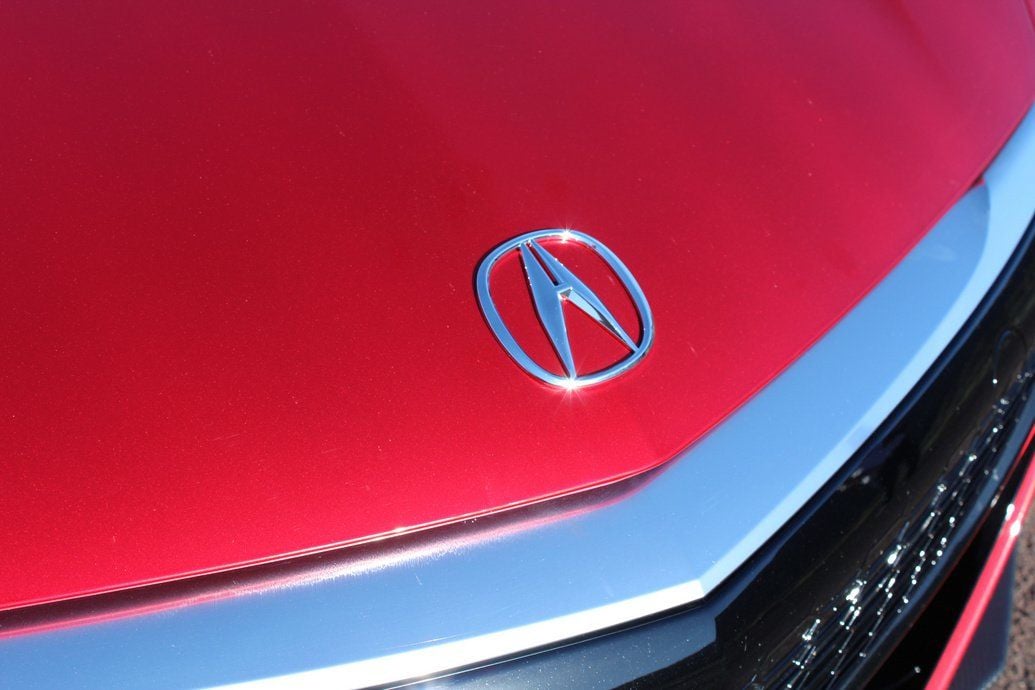
Form follows function
The NSX has all the typical styling hallmarks of a high-end sports car, but there is a lot more technical stuff going on than meets the eye. Rather than just channeling air around the car, engineers worked tirelessly to divert passing air through the NSX.
That channeling system starts up front with 3 large inlets located in the lower portion of the NSX's front fascia. Those ducts help pass air through the NSX's front radiator and also provide cooling for the electric motors mounted in the center of the front axle. In order to ensure that incoming air doesn't create unwanted front-end lift, designers fitted functional air extractors on the NSX's hood and on the front fenders just behind the front wheels.
Once air exits those ports, it's either funneled down past the rear wheels or sucked back into the large vents located just behind the NSX's doors. Hidden inside those cutouts are intercoolers for the turbocharged engine, as well as ducts that channel air to the NSX's 9-speed gearbox. Look closely and you'll spot 2 air outlets just above the NSX's taillights, which work with air coming from under the car to reduce rear turbulence that can cause excessive drag.
Although it was designed with performance in mind, the NSX wasn't penned devoid of aesthetics. The front end shares a clear resemblance to the rest of the Acura lineup, including the 1st application of the brand's jeweled headlight treatment that we don't hate.
In profile the NSX has some Audi R8 in it, but that's not necessarily a bad thing. The rear view of the NSX isn't as successful, with an overall design that comes off as a little bland for such a radical sports car. The angle of the rear fascia is also a little strange; viewed from certain angles you could almost mistake the rear of the car for it's front end.
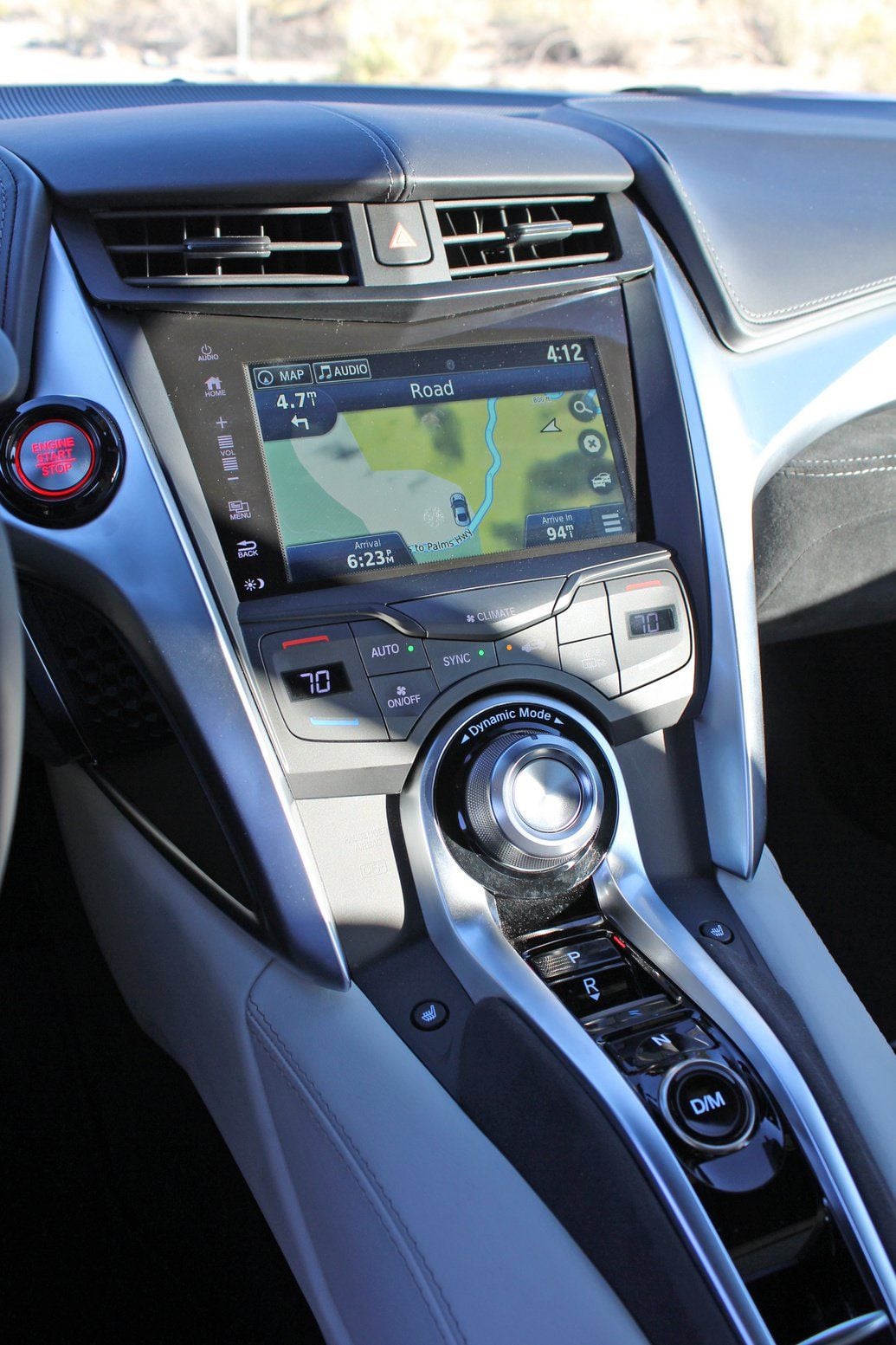
Life aboard
Acura is known as a sensible brand, so it should come as no surprise that the interior of the NSX reflects that ethos. Seats in the NSX are comfortable -- even by luxury car standards -- and there is plenty of head- and leg-room for those north of the 6-foot mark. Outward visibility -- a hallmark of the original NSX -- remains a strongpoint for the 2017 NSX thanks to an expansive windshield and a rear window that is large for a mid-engined car. Heck, even the NSX's trunk is large enough to swallow a couple of bags or even a full set of golf clubs.
Unfortunately, the overall design of the NSX's interior is a little too sensible. Everything feels like it's pulled from another Honda product, and that's largely because it is. The NSX's push-button transmission is found in other Acura products and the car's main touchscreen is essentially the same unit you can get in a $20,000 Honda Fit. This interior would be just fine for something like a TLX Coupe, but feels unimaginative for a halo supercar that was developed from scratch.
Some of that Acura sensibility flies out the window once you get to the NSX's ordering sheet, however. Despite a base price approaching $160,000, navigation is a $2,800 option on the NSX. Want SiriusXM satellite radio? That'll be another $500 on top of that. True, brands like Lamborghini charge extra for similar features, but that just seems out of step for Acura. Ditto for the NSX's lack of adaptive cruise control and blind spot monitoring.
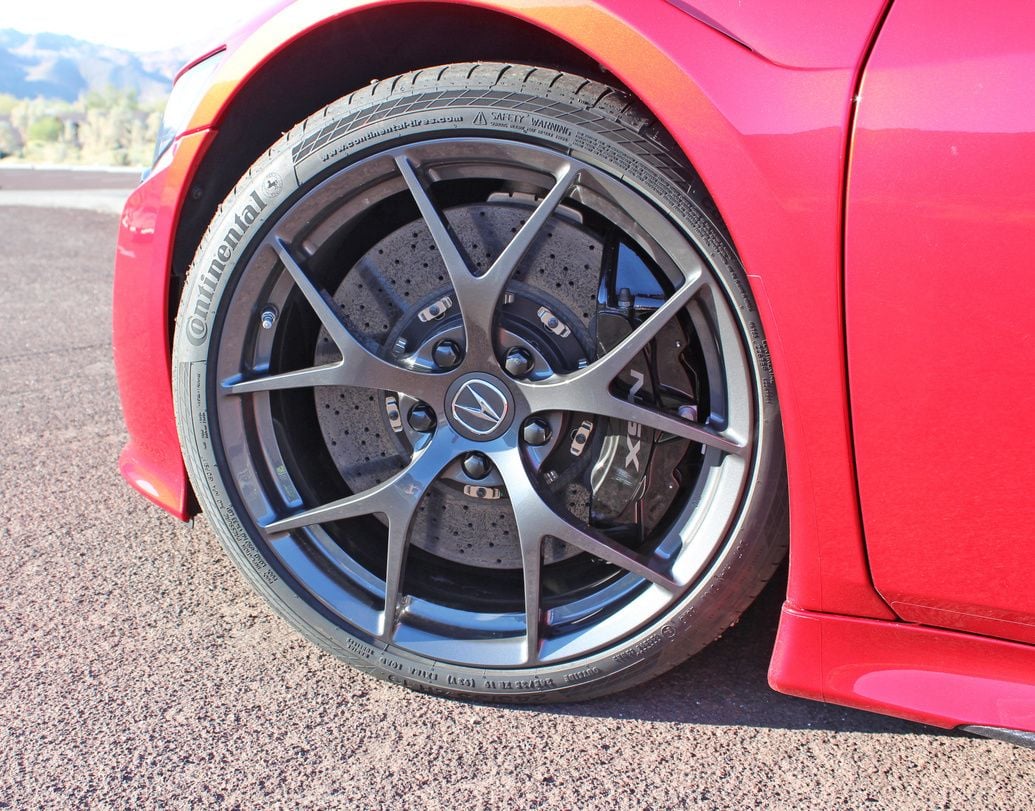
Road and track
It's nice to talk about styling and features, but people are really only interested in the NSX for 1 reason -- the way it drives.
Our 1st experience with the 2017 NSX came on the private pavement of The Thermal Club just outside of Palm Springs, California. Although not a complicated circuit, Thermal's red course provided plenty of curves and long straights to properly put the NSX through its paces.
With the NSX's Track mode engaged, we eased out of the pits and onto Thermal's long straight. Mash the long pedal and the NSX accelerates like a rocket. The electric motor integrated into the NSX's transmission automatically engages on takeoff, eliminating any sensation of turbo lag. And with both turbos fully spooled, the NSX can really scoot.
The NSX's accelerator pedal actually has a built in "step" point for fully activating the twin electric motors at the front end. Push the pedal past that clicking point and the NSX' entire hybrid system works in tandem to shoot you to the horizon line as quickly as possible. Acura isn't releasing 0-60 figures for the NSX but, with launch mode engaged, we wouldn't be surprised to see figures in the low 3-second range.
The NSX is equipped with torque vectoring systems at both ends, which really helps in the corners. At the rear axle the NSX is cable of braking the inside wheel, while the electric motors up front are cable of apply negative force to 1 wheel and positive force to the other. The end result of that electronic wizardry is a car that is extremely easy to hustle through tight turns.
Since it uses an electric power steering system, the NSX doesn't offer a whole lot in terms of steering feel, but the tiller is spot on in every other regard. Any inputs are met with a proportional response from the front wheels and the "gearing" is just about as perfect as you can get -- no hand shuffling is necessary here, just put your hands at 9 and 3 and keep them there for every turn of the track.
The NSX checks in at a rather portly 3,800 pounds (nearly 700 pounds more than a Lamborghini Huracan), but most of that mass is packaged extremely low in the NSX's chassis, so it carries its weight well. That heft does tend to rear its head through fast corners though, with mean Mr. Physics providing a subtle but constant tug toward the outside. If you do cross the limit, the NSX is forgiving; drifts are easily controlled and the all-wheel drive system is quick to pull you back in line.
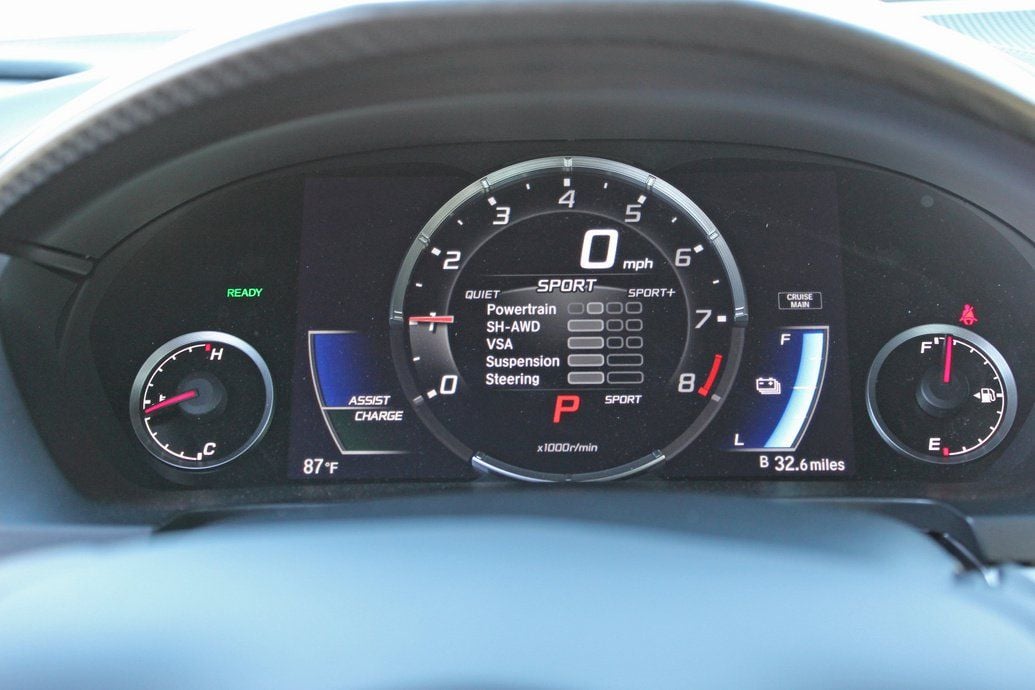
Our test cars were fitted with the NSX's optional Pirelli P Zero Trofeo R tires, which proved to be the most responsive of the 2 tires we tested, the other being NSX's standard Continental tires, but more on that later. Michelin Sport Cup 2 tires are also available for buyers that are planning to do some track driving.
The NSX's optional carbon ceramic brakes had no issues with the car's big bones, hauling the nearly 2-ton supercar down from speed with ease. We were limited to about 4 laps per track session, but during that time we never experienced any signs of fade. Regenerative braking is also included in the NSX and never felt obtrusive.
The NSX's 9-speed transmission works well in either its automatic or manual settings. But truth be told, we probably prefer the automatic setting to the NSX's steering wheel-mounted paddles. The NSX is so technically advanced that it's just best to leave it to its own devices.
The aural experience can be just an important as the driving sensation in a supercar, and this is 1 area where the NSX could use some improvement. The V6 sounds decent in the mid-part of the rev band, but its howling can be borderline annoying once the RPMs really start to climb. Part of the problem stems from tubes that transmit intake sound from the engine compartment to the cabin, terminating just behind the head of the driver and passenger. As a result, it's almost impossible to hold a conversation while driving above 5,000rpm. And despite all that noise, you really don't hear much from the twin-turbos, which seems like a missed opportunity. We'd gladly trade some of the NSX's intake noise for the chirping of the turbochargers.
So how is the NSX on track overall? Very good, but somehow lacking that emotional connection that makes it a truly moving experience. That feeling will obviously vary from person-to-person, but the NSX didn't beg us to keep pounding lap after lap.
However, there is good reason for that. Although the NSX is track-capable right out of the box, it was really designed with street use in mind. And out on the roads of the real world, it really shines.
Rather than thinking of the NSX as a full-on supercar, think of the NSX as a super grand touring car -- fast, but with plenty of space and comfort. When you just want to cruise around town, flip the NSX's dial to Quiet mode and it will loaf around as silently as an RLX sedan. And with its 3rd-generation magnetic ride dampers, the NSX is just about as comfortable as Acura's flagship sedan.
Sport mode livens up the NSX's drivetrain, but keeps the active exhaust flaps mostly closed, so the car's cabin isn't flooded with engine noise.
Sport+ prods the NSX's powertrain a little more, while also livening up the car's suspension and steering. With Sport+ mode engaged and a winding mountain road ahead, the NSX really comes into its own. The AWD system instills gobs of confidence while the NSX's torque vectoring seems to bend the laws of physics -- tight turns are no match for this car. Moreover, we didn't experience any moments of turbo lag or even transitions between the gas-electric powertrain, resulting in a linear connection between our right foot and a rush of forward movement.
The NSX's standard Continental rubber provided enough grip on the road, but lacked some of the feeling offered by the Pirellis. Since there isn't a ton of road feel to begin with in the NSX, we'd probably keep the car's track tires fitted at all times.
Again, our only real complaint about piloting the NSX at speed is its off-putting engine note. Unlike the Lamborghini Huracan, which only gets more soulful as its pistons spin toward redline, the NSX doesn't really compel you to hold an engine note to full crescendo. But other than that, the NSX makes for a near-perfect canyon carver.

Leftlane's bottom line
In a world flush with supercar options, the NSX manages to carve out its own unique niche. Although not as impassioned as some of its European counterparts, the NSX brings to the table a (comparatively) affordable hybrid drivetrain and the the kind of space, comfort and reliability that makes for an everyday supercar. Hopefully Acura doesn't make us wait another 10 years for another bite of the carrot.
#50
Safety Car
Thread Starter
Rushing down some backwoods highway in the California canyons, the feeling of rock and pine flashing by at warp speed past the window—we were moving at speeds any California Highway Patrol officer would conclude to be ‘reckless.’ I didn’t care, the Acura NSX I was piloting didn’t seem to give a damn either, it continued to push the limits of what was possible; on the corners, in the straights, and everywhere in between.
If you were looking for a lightweight supercar similar to the NSX you saw a decade ago, this wasn’t it. This was something far more advanced, seemingly from another era far beyond our time. A twin-turbocharged engine, 2 electric motors, and space-ship like design. This was a car built for the future, and here I was, in 2016, driving it quick.—dangerously quick.

For Acura, the NSX comes at a very important time. The brand is struggling to reinvent itself, because sometime between 1990 and 2016, Honda’s luxury marque strayed into the desert to do some soul-searching, eventually finding itself by creating vehicles 1 would consider far from ‘acceptable’ in the realm of luxury manufacturers.
It’s definitely a tough pill to swallow for everyone involved. But the 1st part of reinventing yourself is realizing your mistake. The 2nd part is putting that signature Honda “power of dreams” slogan to good use, proving to everyone that anything is possible. Things like the NSX are possible.
To understand this car you have to understand the entire thought process behind it. The new NSX was built in Ohio (yes, that’s the United States), at a facility designed specifically to build the new NSX. This further reassures everyone that Acura wants to continue its separation from the Japanese-built original. And that’s not a bad thing.
For 1, the technology on this car is bar none. It’s almost as if McLaren shrunk down its P1, made it look better, and slapped an Acura badge on it. The 3.5-liter V6 shares space with 2 electric motors—1 in the front, 1 in the back—to which a total of 573 horsepower and 476 lb-ft torque are produced. That’s not slow, and even without an official 0-60 mph figure to work with, I can tell you safely it’s somewhere in the 3 second range.

With an ample amount of power on hand, 1 of the things the NSX truly excels at is launch control. It’s as easy as transferring the car into Sport+ mode, mashing your left foot on the brake, right foot on the gas, and waiting for a sensor to tell you to get your ass up and go. As soon as you release the brake, a full G of force is thrust onto your chest. There’s no wheel spin, no fuss, no nothing to convince you that this isn’t 1 of the best systems money can buy.
Putting to use both the electric motors and the 3.5-liter V6, Acura’s power distribution is something of wonder. If you were looking for turbo lag—look somewhere else. Power is immediate and aggressive, just like any good supercar should be. The dual threat of electric and gas gives you gobs of power. Comparably, it’s a more efficient, though slightly convoluted approach to power than any of its segment competitors.
Hold the 9-speed gearbox to 7,500 rpm and it cycles through gears while the speedometer climbs faster than you can blink. It works flawlessly in the straights, putting down the right amount of power right when you need it. But that isn’t to say Acura’s 9-speed autobox is perfect. Far from it, in fact.

It took Acura only 18 months to develop its new gearbox, and it shows. In the corners—specifically on the track—it seemingly wanders around under the hood, searching for the right gear at the wrong time. Holding 1 for too long, not downshifting quick enough for another. By then, you’ve already clipped the apex going 2 or 3 mph slower than you should be. You can combat that by using the paddle shifters, but even then, it’s not even comparable to cars like the R8 or 911 relative to preciseness.
The steering rack follows a similar issue. Unless you’re in Sport+ or Track, which is quick and precise, it doesn’t feel a whole heluva lot like a $150,000 supercar. Depending on the type of person you are, that may ore may not be a good thing. Sport mode is comfortable, definitely, and Quiet mode is efficient, sure, but the steering is numb, and the all-wheel drive system doesn’t work well in unison with the suspension, leading to a healthy amount of understeer.

Acura’s saving grace for its senseless steering rack comes in the form of a $2,900 optional steering wheel. You get more than just a steering wheel, of course, (carbon fiber accents, etc.). But it’s the most important part. The steering wheel feels as if it was designed for you specifically. Yes, you. The way it contorts to your hand—every inch of your palm and fingertips are connected at once, giving you a better sense for the road. It’s like Acura engineers looked at a glove and said, “how can we make this into a steering wheel?” And they did.
Sure, a steering wheel might sound like a trivial thing, but this is the single best steering wheel my hands have ever touched in a road car.

There’s definitely a lot of detail in the new NSX. Arguably, too much for a single review. But when it comes down to the brass tacks, negativity aside, the NSX really is a marvel of engineering. 80% of the time it works every time. Even after tracking it, and moving at a healthy clip through the canyons, it returned 19 mpg, showed off its faultless all-wheel drive system, and looked good doing it. Really good.
For $156,000, with all the technology and over-thinking, the NSX doesn’t herald back to the original in the way you were hoping. But that’s ok. The way it does share similarity with the original product is its push for new technology. A feat of engineering—just like the original—but in a very different way.
It’s attractive and sustainable and previews a future—whether you like it or not—that’s coming right for you. Culminating performance, efficiency, and design, into a well-thought out, fun-to-drive package. That’s the true beauty of the Acura NSX.

Specs
Engine: 3.5L Twin-Turbo Hybrid V6
Horsepower: 573
0-60: 3.0 Seconds (est.)
Price (base): $156,000
Positives
Stunning design
Advanced technology
Track focused
Negatives
Numb steering rack
Cheap interior plastics
Engine: 3.5L Twin-Turbo Hybrid V6
Horsepower: 573
0-60: 3.0 Seconds (est.)
Price (base): $156,000
Positives
Stunning design
Advanced technology
Track focused
Negatives
Numb steering rack
Cheap interior plastics
#51
Safety Car
Thread Starter
To Generation X, the letters “NSX” meant something. Maybe to the men and women of Minato, they meant “New Sports eXperimental,” but to us, they represented the dreams of our adolescence. Even in the 1990s, an elegant era of Japanese car design that brought us the best versions of the Mazda RX-7 and the Toyota Supra, the NSX stood alone as a paragon of technology and fascination. Talk about a tough act to follow for this new 2017 Acura NSX.
To those of us old enough to remember, yet young enough to wonder, the original NSX represented more than any marketing materials, any aspirational branding or any numbers on a spreadsheet ever could. The exotic from Acura, and not the offerings from the European, Paleozoic brands of Ferrari and Porsche, was the car that many people my age pictured ourselves owning someday as the sign that we had made it.
Thus, when it was announced in 2007 that Honda would be bringing the NSX nameplate back to life before the end of the decade, anticipation was palpable. So was skepticism. It had so much to live up to. 1 thing that helped was the exciting revelation that Honda would be using a new V10 engine to power its reincarnated supercar.
So we waited. And we waited.
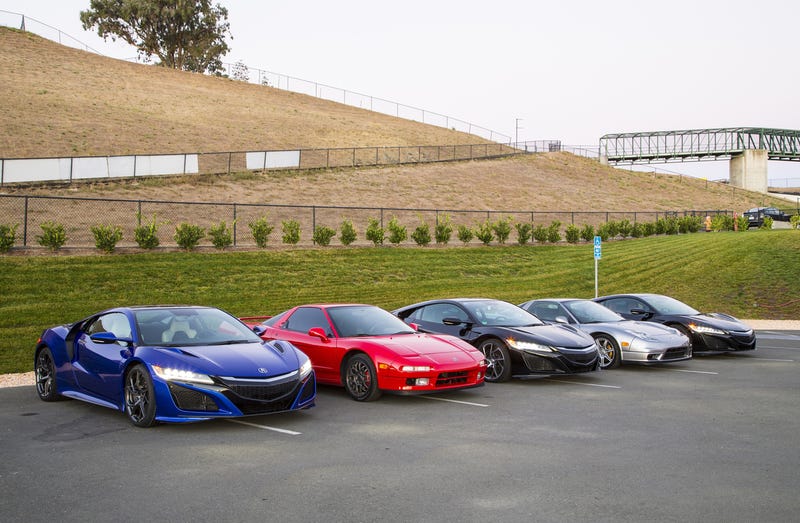
Rarely has there been so much hype, buildup, and anticipation for a car as there was during the not quite decade of time that we’ve waited for this new NSX. Promises were made, broken, and then made again. A global recession and then a devastating Japanese earthquake sent Honda back to the drawing board more than once.
2010 came and went, and with it, the idea of the V10, making way for a twin-turbo V6 hybrid. Maybe we wouldn’t be getting a big, thumping, brute force-powered supercar after all, but rather a refined, technological, marvelous scalpel? Then when it finally seemed within our grasp, Acura completely re-engineered the entire thing.
Well, it’s now 2016, and Acura has at very long last, delivered on a new NSX. But have they possibly delivered on the promise of the NSX as well as the name?
(Full disclosure: Acura needed me to drive the new NSX so badly they provided airfare to Palm Springs, 3 nights at the Ritz-Carlton Rancho Mirage, and enough food and wine to feed a small village, and also make said village drunk-dial neighboring small village and tell them how much it misses them.)
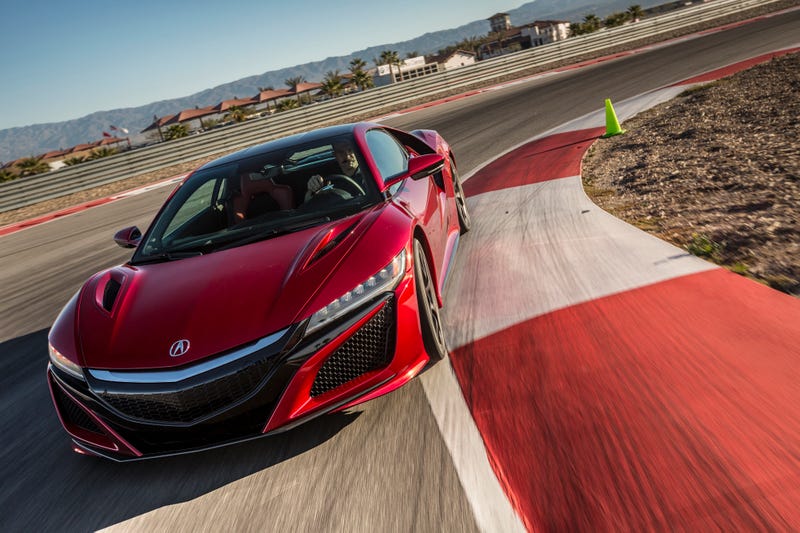
The Specs That Matter
The new NSX is powered by a system that’s truly unlike anything we’ve ever seen in a car that stays south of the $200,000 mark. The Sport Hybrid SH-AWD power unit is made up of an all-new, NSX-exclusive, twin-turbocharged, mid-mounted 3.0-liter V6 engine paired with an all-new 9-speed dual clutch transmission and an electric Direct Drive Motor which not only provides instant torque, but also charges the hybrid batteries.
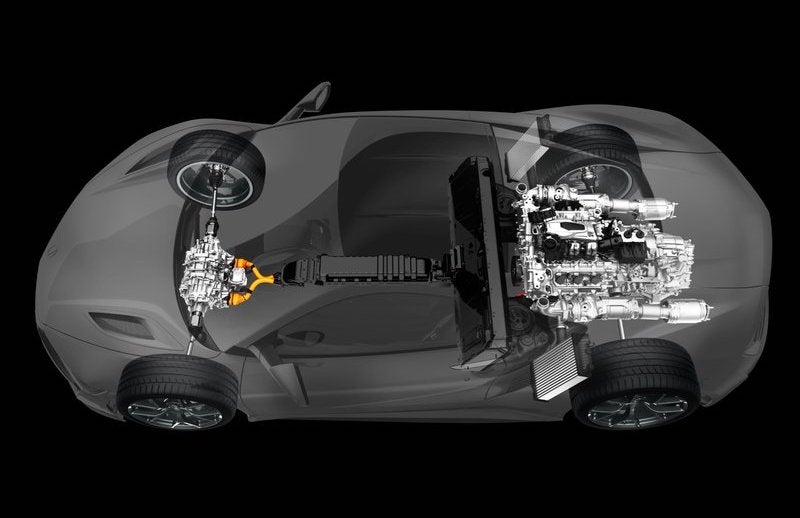
Supplementing this are 2 electric motors at the front of the car, which Acura calls a “Twin Motor Unit”, that provide power independently to the front wheels, meaning that it that is capable of providing real torque vectoring to all 4wheels whenever a driver needs it.
So what does all that techspeak really mean? I’m sure that there’s some ecologically responsible reason for all of this hybridness, but what I suspect you really care about is that the power comes on, like, now, with literal neck-snapping acceleration forces of over 1G. And it also provides a very non-supercar-like combined 21 MPG.
The complete package comes in at 3,803 pounds, which, quite frankly, sounds more Mustang than NSX. The heft does nothing to slow it down in a sprint, however, thanks to a combined 573 horsepower and 476 lb-ft of torque from the SH-AWD system.
Aided by a wickedly good launch control and, of course, all-wheel drive, the NSX will thump out a0-60 MPH jaunt in exactly 3 seconds flat.
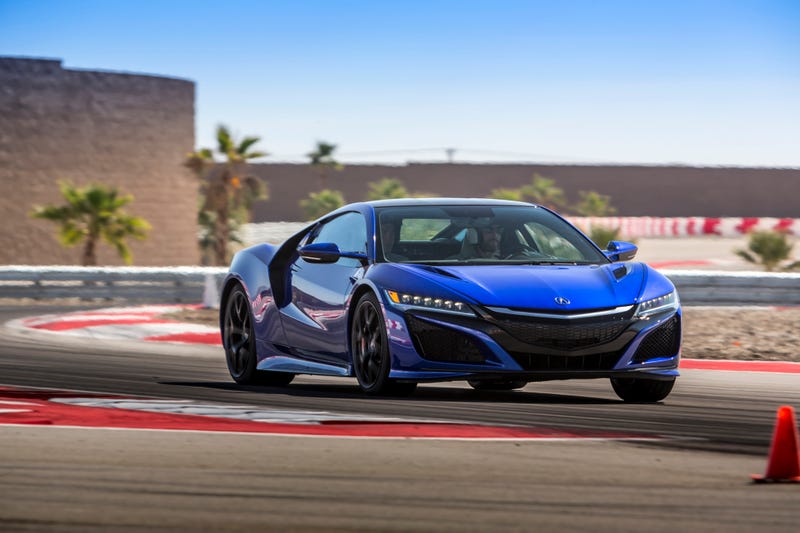
Visually, Acura has created a captivating car. The exterior manages to be appropriately exotic while still cutting a silhouette that recalls the Japanese supercars of yesteryear—there’s no mistaking it for almost anything from the Continent.
If you want to turn heads, the NSX will undoubtedly make waves, even in a desert town like Palm Springs. Every time I parked the NSX out in public, camera phones started clicking like Beyoncé had just arrived. (For everyone who saw that I was not, in fact, Beyoncé, sorry to disappoint.)

The seats are also exquisitely designed. There’s enough lateral support for the most spirited of driving, yet comfort isn’t sacrificed at the altar of performance. Cross country drives aren’t just possible in the NSX, they’ve been done.
Acura engineers drove from the Ohio factory to Utah and back in order to do some testing at the former Miller Motorsports Park. In leather-trim, this is an interior that’s cool enough for pretending to be Johnny Tran, but sophisticated enough for listening to Johnny Mathis.
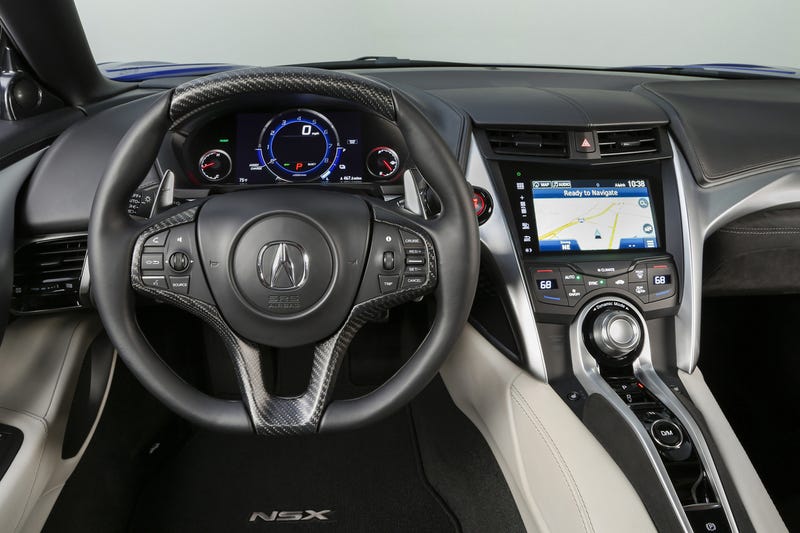
If you want your own NSX, well, it’s not just as simple as going down to the Acura dealer and picking 1 off the lot. Each NSX will be a special order, with much of the car being handmade in Ohio to its new owner’s specifications. Sticker price will start at $156,000, but to get the brakes, carbon fiber, and audio that you really want, be prepared to pony up closer to $200,000.
Track Tested
My New Sports eXperience was to begin bright and early at the Thermal Club, a private, country-club track nestled in a jarring juxtaposition between fields tilled by immigrant workers who begin their workday before the break of dawn, avoiding the sweltering heat of a town bold enough to call itself “Thermal.”
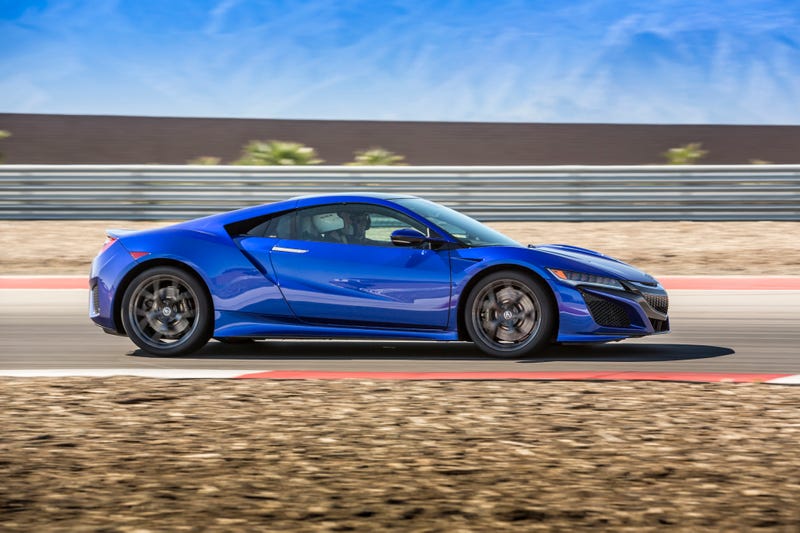
Acura arranged for Pirelli World Challenge RealTime Acura Drivers Ryan Eversley and Peter Cunningham to conduct the lead/follow session. Each of us was given 3 15-minute sessions on track, as Eversley and Cunningham took it in turn to cut a virtual set of ski tracks through the asphalt of the South Palm Circuit for 3 drivers at a time to follow.
The track is an exercise in patience, with plenty of run off in every tight, slow corner, giving very little chance for any journalist to mangle a 6-figure, pre-production car.
As is often the case at press drives, the on-track experience of those in attendance ranged from “never on track before” to “Indy 500 top-5finisher Alex Lloyd.” As such, I wasn’t able to gain much perspective about the driving performance of the NSX on track until my 3rd and final attempt, when I was situated directly behind Eversley, who was taking recently minted Acura VP and GM Jon Ikeda around in the passenger seat of his new baby.
“Game on, sucker,“ I said as I situated myself in the driver’s seat of the NSX for what would be my final track session.
“I’m sorry?” said 1 of the chief designers of the NSX, from my passenger seat.
“Um, nothing.” Damn. Kinda forgot you were sitting there, bro.
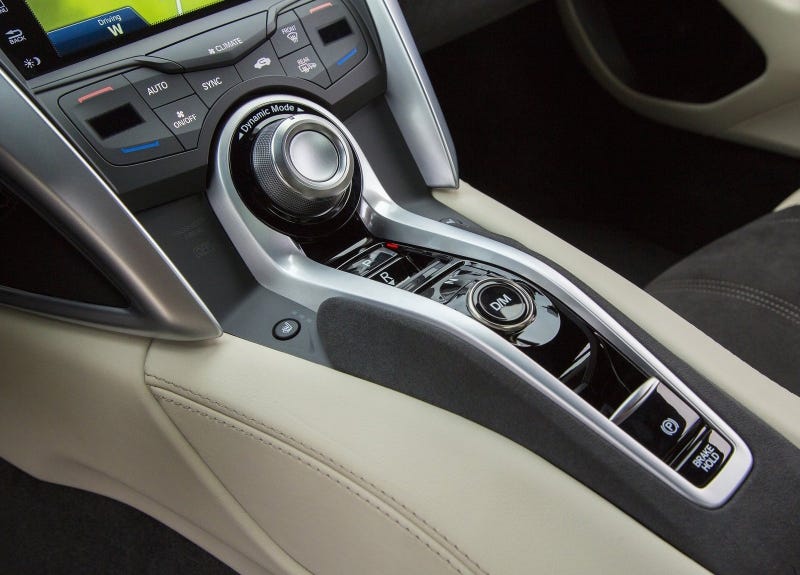
I used the large dial in the center stack of the NSX’s console to select Track Mode (the most aggressive and certainly the loudest of the 4 NSX drive modes), turned the VSA traction and stability control to “OFF,” and followed Eversley out onto the track. Game on, indeed.
Although the Thermal Club’s layout wasn’t necessarily conducive to an all-out track battle, Eversley didn’t let that stop him from going all out, daring me to stick as close to him as possible.

“Bark, I’m going to ask you to back off his bumper just a bit,” my passenger shouted over the shrieking twin-turbo V6 slung low behind us. “We’ve lost some windscreens this way.”
I saw what he meant—the massive 305 series Pirelli track tires of Eversley’s red Barchetta hurled rocks from the less-than-spotless surface of the circuit as we transitioned back through the esses into the straightaway.
My attempts to continue to carry on any sort of conversation with my passenger became hopeless as soon as the chase began. The sound of the twin-turbo V6 isn’t as awe-inspiring as the V10 of Audi’s R8 or as guttural as the Corvette Z06’s LT4, but, in Track Mode, it is assuredly as loud as you’d want it to be.
It creates a tone that reminds 1 of a car from the Jetsons-ish future that never was—well mannered, scientific, and methodical.
Better, Smarter, Faster... Than You Are
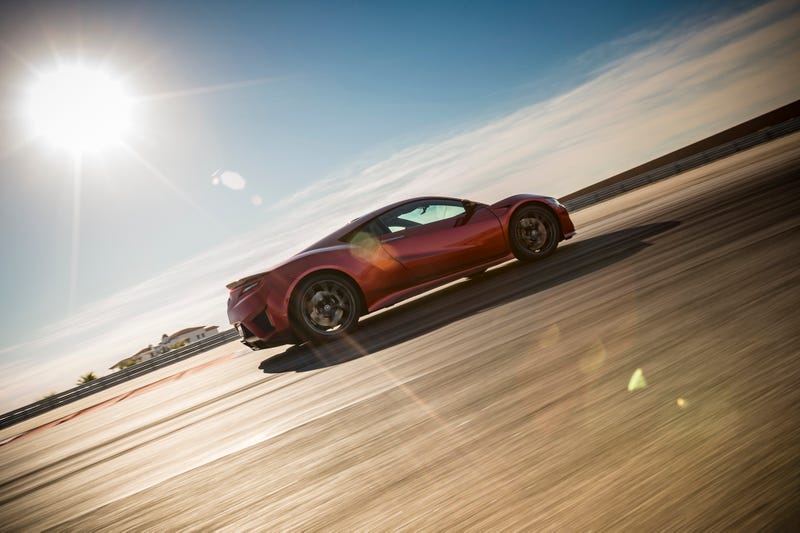
The SH-AWD system pulled me through corners with the merest application of throttle, allowing the torque vectoring to urgently direct power to the front wheel that needed it most. It’s almost never wrong to put the power down in the NSX on track. The car only gave me as much power as the traction could handle. Earlier was nearly always better.
In a few turns, our fellow NSX drivers had become mere blips in my mirror, and by the end of the 1st lap, they were gone. And Eversley, had he been so inclined, could have made me a blip, too.
What I realized in my futile attempt to chase down a World Challenge driver was this: on track the NSX does everything better than you, the driver, can.
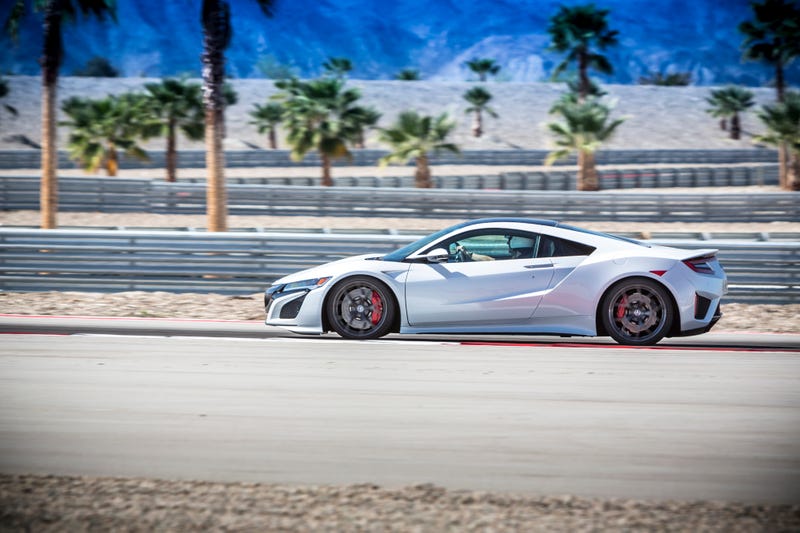
Acura took aim squarely at Porsche’s PDK with their bespoke 9-speed transmission and it doesn’t disappoint. It downshifts and matches revs far better than any mortal. While the NSX tends toward a less hairy understeer in the turns, give it just a little trail braking into any corner and watch the oversteer come on slowly, but surely, and more importantly, predictably.
It even brakes better than you can, taking your inputs as little more than powerful suggestions as it applies the proper amount of pressure for you. It sloughs aside your sloppy throttle inputs at apex and dials in the throttle just so, positioning the car on exit exactly where it should be.
But even though I had a smile on my face as I returned to the pit road, I couldn’t help but feeling that it was all a bit Paint-By-Numbers. On track, the NSX drives like the fastest Japanese sedan you’ve ever driven—ever careful to mind its manners and provide a comfortable driving experience, even at the 140+ MPH the NSX effortlessly nosed past going into Turn 7.
The engineers told me that they had benchmarked it against the 911 Turbo S and the 458 Speciale, and it’s entirely possible that the NSX could be just as fast as those supercars on the course—maybe even faster.
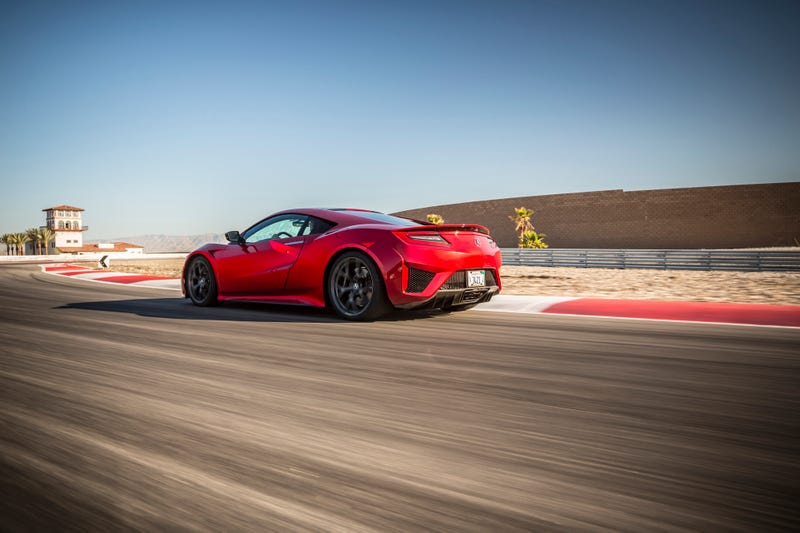
But the visceral experience just wasn’t there. The sound wasn’t quite raucous enough. The grip wasn’t loose enough. The visibility was—well, I could see out of this supercar! That just isn’t right, you know?
Driving a car this fast and this expensive is supposed to be somewhat of a chore, the kind of chore that you humblebrag about to your friends (“Oh, that 1st-class flight to Milan was just murder.”)
And then I realized why I was pouting. The NSX was just too easy to drive on that track. I was genuinely pissed off by the fact that the electronic nannies were making me a better driver, that all my track time and laps behind the wheel of cars costing less than 1 10th of the NSX were rendered somewhat irrelevant by the NSX’s superior intelligence.
It’s not a 991 GT3, ready to whip its tail out at a moment’s notice to punish its driver for his sins. It’s not a Shelby GT350R, wailing at pitches previously only known to banshees. It’s a perfectly composed, neatly packaged, dare I say… luxurious track car.
And when you understand the purpose of the NSX, you begin to understand that Acura got it exactly right.
It Wins On The Street
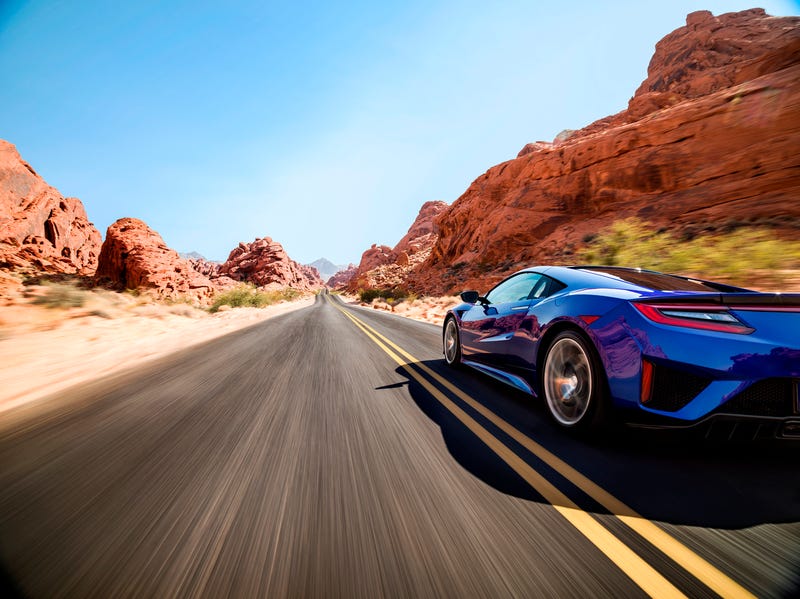
The NSX wasn’t designed to be purely a track car. While the typical NSX owner may track his car anywhere from 3 to 4 times per year, the rest of the time, the NSX is intended to be a real, viable street car that owners can comfortably and easily daily drive, while still obtaining the feeling of maximum performance. So it was time to leave the track and test the NSX in the environment for which it was truly engineered—the road.
As I exited the Thermal Club, I was given a route through the San Jacinto Mountains to return to the hotel. Since we had left the track, I switched the NSX into “Sport Plus” mode, plugged my iPhone into the USB port, activated Apple CarPlay, and let the combined sound of the Christian McBride Big Band blasting through the 580-watt ELS Surround Sound System and the motor wash over me as the NSX and I became symbiotically 1 through the undulations of the mountain roads.

The true greatness of the NSX lies here. Not on the track, but in the real, dirty, non-antiseptic world. The magnetorheological suspension digests every bump, every divot, every patch of gravel with not only ease, but indifference.
While the 991 and the 458 might be the more organic way to make one’s way around a circuit, it’s hard to believe that the NSX couldn’t show its rather attractive hindquarters to either in the hills and canyons of southern California.
The confidence that it inspires is intoxicating. No matter the turn, no matter the camber, no matter the debris strewn across the road, the NSX simply sticks. The speeds that the Acura makes possible on public roads are not just illegal, they’re felonious. But if 1 simply must have a felony on one’s record, this would be the way to get it.
The Verdict
So is this NSX a fitting descendant of the older car that I loved so much growing up? Yes. Well, maybe.
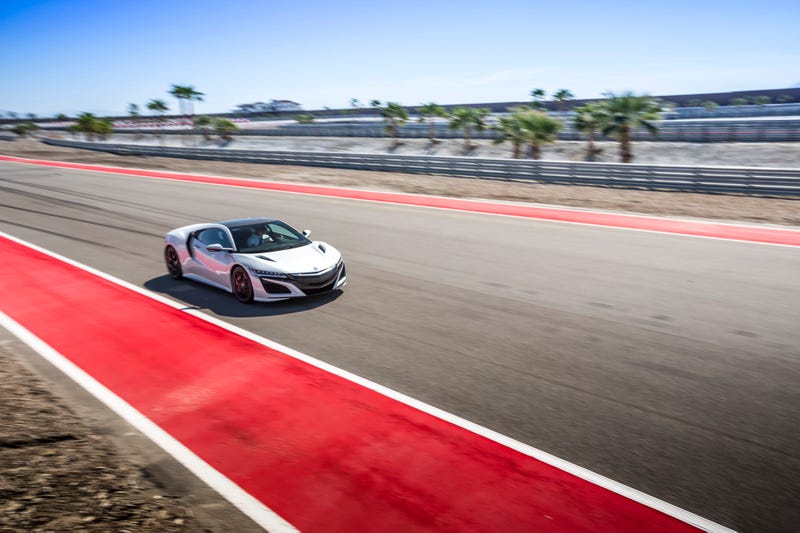
After the road drive was completed Acura was kind enough, or perhaps foolish enough, to toss me the keys to a company-owned 2005 NSX. It was not a museum piece. It was a 47,000-mile example. The seats weren’t perfect. The steering wheel had faded over the years by the California sun.
And while the original NSX may have been a technical marvel in its day, to drive it now serves as reminder of a time when the best cars communicated in analog fashion. They reacted to your inputs. They had a dialogue with you. They became 1 with you, the driver.
This new NSX asks you to become 1 with it. To envelop yourself in its comfort, its luxury, its technology, to become as much of a hybrid as it is.
What Acura has done with this new NSX is to take a driving experience that was previously only accessible to the gifted and allow the ordinary (if rather wealthy) man to fly just close enough to the sun to revel in its power and beauty. And if, in order to fly that close, 1 has to wear a suit of technological armor, is that a price that they should be willing to pay?
That’s up to you. Me? I say it, quickly and easily, without hesitation: hell yes.
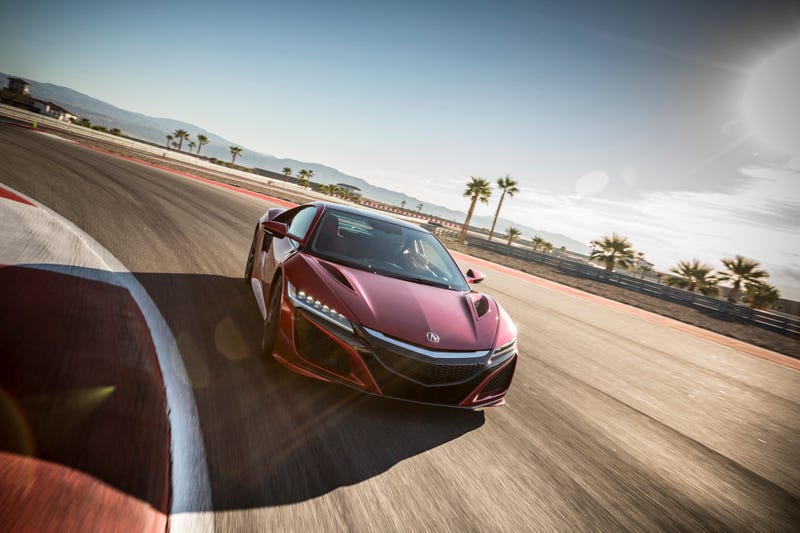
#52
Grandpa
Join Date: Dec 2003
Location: Virginia, Besieged
Age: 68
Posts: 7,596
Received 2,609 Likes
on
1,475 Posts
Some interesting differences of opinion are beginning to pop up about whether the transmission shifts well by itself.
I wonder if it comes down to a particular corner on a particular track.
I wonder if it comes down to a particular corner on a particular track.
#53
Drifting
Someone needs to stop putting these tests and pictures up. Hmm, let me think - a new NSX versus kitchen remodel. Or stated differently, continued wedded bliss versus a solitary future of driving a really, really cool car.
#54
Team Owner
iTrader: (2)
Join Date: Jan 2008
Location: Kansas City, MO (Overland Park, KS)
Posts: 36,545
Received 6,470 Likes
on
5,162 Posts
There seems to be a lot of talk about an NSX-R today. How about this....let's get the first one out-we've only been waiting for years. THEN.....we can talk about an R model.
I was at my dealership today.....they're not really sure when they'll see one. They're hoping by the end of June.....maybe.
I was at my dealership today.....they're not really sure when they'll see one. They're hoping by the end of June.....maybe.
#55
Grandpa
Join Date: Dec 2003
Location: Virginia, Besieged
Age: 68
Posts: 7,596
Received 2,609 Likes
on
1,475 Posts
My little dealer out here has still not seen any RLX Sport Hybrid to sell other than the one I bought.
#56
Drifting
My understanding from my dealer is that most NSXs will be built to order. They will be shipped to the dealer, where the ordering buyer will pick them up. They do not think they will have any "inventory" cars on site and expect to sell only a few of them. We'll be extremely lucky to catch a glimpse of one and that will likely be limited to seeing new owners taking them on public outings.
#57
Safety Car
Thread Starter
It’s been a hot minute since Acura launched a true supercar. The last time we saw a salacious, ceiling-smashing, mortgage-busting 2-seater from Honda’s upscale outfit, Ayrton Senna and McLaren were dominating Formula 1.
That was 1990, when the Acura NSX crashed the supercar party. It was a revelation for Honda—a company known more for thrifty, utilitarian cars that ran forever—and an unexpected challenge to contemporary exotics from those guys in Italy. The NSX combined groundbreaking tech like an aluminum chassis and titanium engine valves with the comfort and reliability of an Accord to create a supercar you could commute in.
The original NSX, amazing as it was, eventually became a historical relic, unable (or unwilling) to compete in the horsepower wars of the past decade. The 2017 model faces the challenge of living up to its predecessor, matching potent rivals, and delivering driving emotion before the machines take the wheel from humans.

Quarter-Century Cycle
In the 25 years since the 1st NSX drew auto enthusiasts to the east, hypercars from Ferrari, Porsche, and McLaren have evolved from thirsty, big displacement beasts to smart, sophisticated hybrids with all-wheel drive and bogglingly complicated drivetrains.
The 21st century take on the NSX, which starts at $156,000, follows the same path. 3 motors join the mid-mounted, twin-turbo V6 in sending power to all 4 wheels. It’s a convincing package. The engine is good for 500 horsepower and the motors offer another 73, propelling the car to 60 mph in 2.9 seconds and a top speed of 191 mph.
All manner of computerized logic helps with acceleration, cornering, and lap times. There’s a lot of thinking to do. Just to cite 1 example, 2 of the 3 electric motors drive the front wheels, each operating independently to ensure torque goes exactly where it’s needed. During hard cornering, extra power goes to the outside wheel. Meanwhile, the motor driving the inside wheel flips into generator mode, slowing the wheel to make the car turn in faster and sending the recuperated kinetic energy to the battery.

Behind the Wheel
Climb into the NSX’s 2-seat cabin, an overwhelming sense of Honda-ness greets you. The integrated, center-mounted shift control mechanism, those familiar graphics on the shape-shifting digital display, the accommodating, ergonomic friendliness that speaks of benign functionality.
The vanilla overtones are spiced with pleasant details, like the peekaboo aluminum structural member in the dash between a swath of Alcantara and leather, which designers say is a nod to naked sport bikes, and the way the cool display morphs its design between drive modes. A sense of restrained tautness governs the cabin.
The NSX lets you drive in full electric mode, and, in addition to standard modes like Sport, Sport +, and Track, there’s Quiet. As in, chauffeuring your mother-in-law quiet, or don’t-wake-the-neighbors-as-you-head-to-work quiet, or Airwolf air-to-ground surveillance stealth mode quiet. Your demographic may vary.

On the Track
My 1st go at Sonoma Raceway reveals a buttery smooth ability that complements the raw power numbers. The combination of internal combustion and electric motivation delivers a smooth whoosh of energy leading up to peak torque, between 6,500 and 7,500 rpm. There’s no lull or soft spot within that crescendo, no surge or spike, just a constant pull of power.
Away from the track, the NSX is commanding and confident on public roads, devouring s-curves and straights as though the frunk were piled with get-out-of-jail-free cards.
Launch control is similarly drama-free. All 4 wheels fling the car forward like an aircraft carrier catapult. When you reach the corner, just turn the wheel and feel the surprisingly porky NSX (3,802 pounds) obey without question. The 9-speed transmission does its part, downshifting with a quick and smooth throttle blip and upshifting nearly instantaneously as the computers send just enough power to the wheels that need it most.
Track mode delivers sharper jolts of torque and tire sliding. Though the engine soundtrack cranks up by 25 decibels compared to Quiet mode, the aural mood is more deliberate aircraft than blatty, burbly racecar. Sure, there are some throaty, compelling acoustics emanating from the engine (aided by intake sounds directed into the cabin), but the overall tone is 1 of focused fierceness, not heedless fury.
Switch off all the electric aids and things get sloppier; tracking the car through a corner takes more attention, the car feels looser. But you’re never entirely alone. When I intentionally lift the throttle mid-corner, ready to reapply gas and countersteer to right the car, the damn thing catches itself. Back in the pits, I try in vain to convince Nick Robinson, head of dynamic development, that a car that starts at $156,000 should, for better or worse, let the driver disable all of the nannies and experience the unrestrained glory of 573 horsepower. (Ed.
Anyway. Away from the track, the NSX is commanding and confident on public roads, devouring s-curves and straights as though someone filled the frunk with get-out-of-jail-free cards.
I wonder if the NSX is over-rationalized, a too-smart-for-its-own-good expression of brain over brawn.
1 decision perplexes: The standard tires, Continental’s 4-season Conti-Sport SP, give up grip far too early when driven hard. The solution comes with the more aggressive (and optional) Michelin Pilot Sport Cup 2 tires. Making all-year rubber the standard is like cladding an Olympic sprinter with hiking boots. Oh, Honda.

The Supercar, Cerebralized.
The team behind the NSX is eager and inventive, but I wonder if the NSX is over-rationalized, a too-smart-for-its-own-good expression of brain over brawn. Soft-spoken NSX project lead Ted Klaus is an airy auto philosopher, with lines like, “How can you have something that’s basically complicated and fundamentally heavy that provides a sense of lightness?” Chassis guru Robinson is similarly cerebral, describing his team’s approach to the human machine interface as, “We wanted a degree of linearity so it could be driven not from the upper brain, but from the brain stem.”
If this were a piece of music, the Japanese redux would be less Van Halen’s “Runnin’ With the Devil” and more Bach’s “Well-Tempered Clavier.” And while I miss the sound, fury, and madness of its Italian counterparts—the howling engine, the dance-in-your-hands steering, the enfant terrible street cred—there is something to be said for the Acura’s Porsche-like rationality.
The 2017 NSX is a monument to engineering, refinement, and ultimately, a certain kind of invisibility. While Aston Martin and Bentley build cars with enough panache to considered supercars for the gentleman set, the Acura NSX is the thinking man’s exotic. Or, perhaps, an everyman’s supercar, exploring the themes of refinement and restraint rather than boom, bombast, and extroversion.
Will history be as kind to the new kid? It will take time, patience, and a whole lot of miles to find out.

#58
Safety Car
Thread Starter
The 1st Acura NSX is clearly as popular now, perhaps even more so than when it was 1st introduced, and it still maintains a substantial fan base. Avid devotees mourned the disappearance of the original iconic sports car from Honda’s luxury division, constantly clamoring for a worthy replacement. Well, the long wait has finally ended. Spring has sprung and thankfully, so has the new Acura NSX. The return of the highly anticipated Japanese sports car is now a reality, following the absence of that 1st example more than 2 decades ago – the last of that 1st NSX run came with the 2005 model.
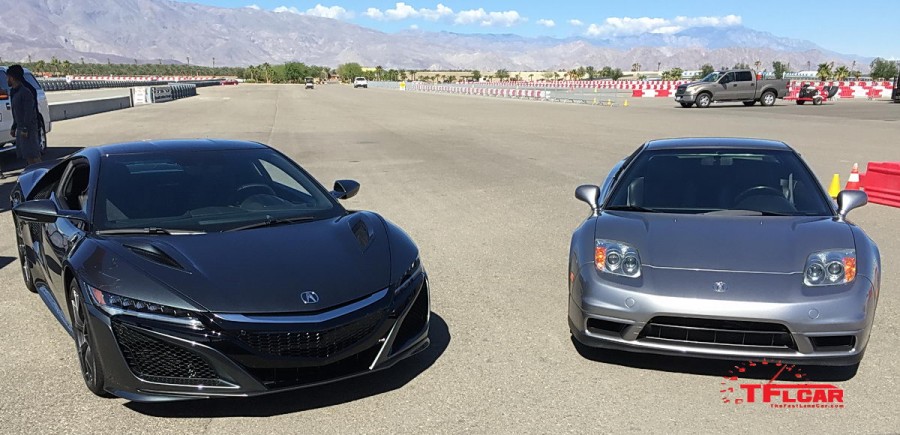
What has now become the 2017 Acura NSX made its debut strictly as an exercise in design in the form of a concept vehicle at the 2012 Detroit International Auto Show, that had yet to be given approval for production. It received such an overwhelmingly positive reaction at the show, however, that the decision to proceed with its development followed shortly thereafter.
The original course of action for the 2nd generation NSX was always for it to be a hybrid model, but significant changes took place over the lengthy period of its metamorphosis, and about halfway through the development process, a more revolutionary approach, with advanced technology became the focus, trumping what was to have been a more conventional hybrid vehicle. Among its many innovations, this latest iteration NSX showcases a “man-machine synergy” approach with its Sport Hybrid Super Handling All-Wheel Drive (Sport Hybrid SH-AWD) – the 1st such technology in the normal realm of supercars, a categorization that it now justifiably warrants. This necessitated changing from a normally aspirated engine in a transverse orientation to a longitudinally mounted, twin-turbo V6, essentially, requiring a completely new clean sheet design.
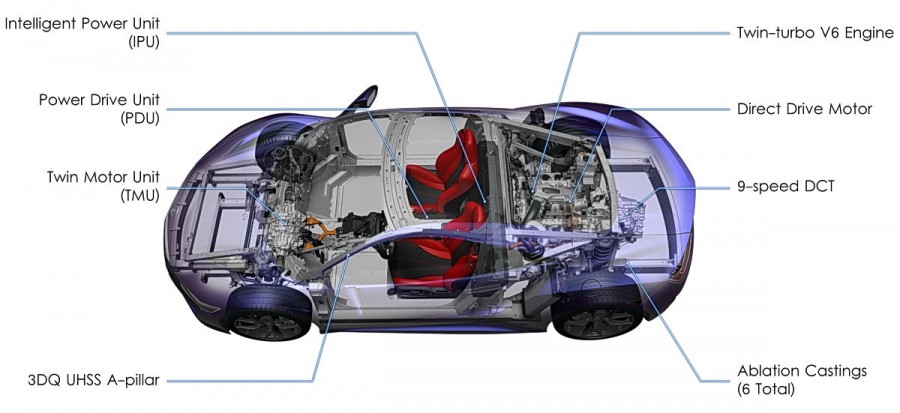
This next generation Sport Hybrid SH-AWD power unit is comprised of the all-new twin-turbocharged, mid-mounted V6 engine that’s mated to an also all-new 9-speed, paddle shifted dual-clutch transmission and Direct Drive Motor that generates instant engine torque response. It also functions as a generator to constantly maintain the hybrid batteries’ charge state as well as consistently supporting driver initiated demands. These rear power unit systems work in conjunction with the 2 front electric motors and the mechanical limited-slip differential, which are enhanced by the capabilities of the front-mounted Twin Motor Unit (TMU).
Encapsulated by the TMU are 2 electric motors that independently supply power to the left and right front wheels, ultimately providing “active AWD”, increasing forward acceleration, and continuously varying both positive and negative torque directed to the front wheels. This action results in a “direct yaw control” effect that enhances agility, stability, performance, and response, or true torque vectoring, which is available at any speed in both throttle-on and throttle off scenarios. The TMU additionally provides regenerative brake force, assisting in braking demands, while at the same time recharging the hybrid battery.
The 9 DCT transmission is purpose built, utilizing a new design, that places the clutch and differential side-by-side in a common housing, with a parallel shaft gear set arrangement.
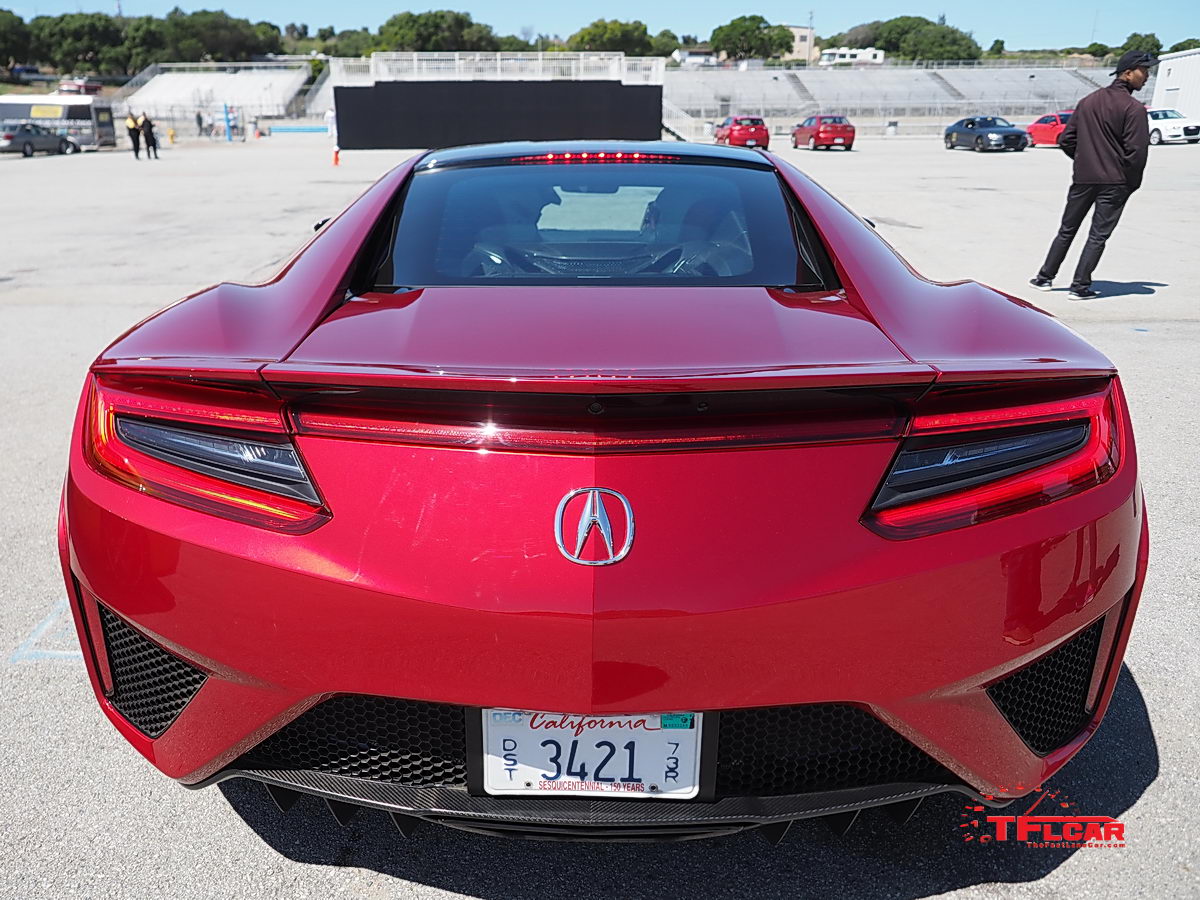
The key hybrid component is the Intelligent Power Drive Unit (PDU) that contains the lithium-ion battery pack. This advanced battery pack consists of 4 modules, each with 18 individual battery cells contained within a specially-designed, caseless structure utilizing the vehicle body itself for a sturdy lightweight housing. The hybrid system’s PDU incorporates a compact “3-in-1” design, converting direct current to alternating current, supplying all 3 electric motors.
All of this is based on a space frame chassis composed primarily of aluminum in a new application – ablation cast aluminum frame members fore and aft combined with 3-dimensional bent and quenched frame members, yielding a high rate of torsional rigidity.
The total motive force delivered by the combined systems is 573 horsepower and 476 pound-feet of torque.
Like the space frame, a mix of lightweight materials for the body’s exterior makeup, including: sheet hydro-formed aluminum for the outer door skins; aluminum stampings for the hood and roof (with a carbon fiber roof optionally available); sheet molding compound for the fenders and deck lid; a carbon fiber front floor panel; and a high-temperature-resistant ABS plastic utilized in proximity of the engine. The composite twin fuel tanks are mounted behind the rear bulkhead in front of the engine.
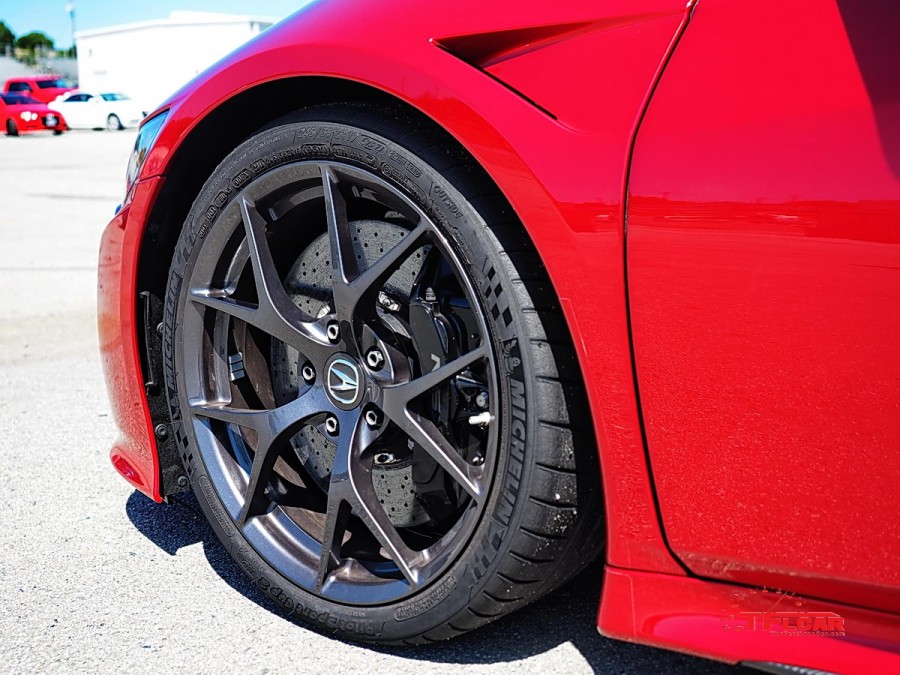
The NSX’s suspension componentry consists of an all-aluminum double wishbone arrangement with double lower control arms up front and an independent multilink setup aft. Active Gen III MR coilover magnetorheological dampers are placed at all 4 corners, with 2 adjustable settings that vary with different drive modes. The Acura supercar rolls on staggered Continental ContiSport tires as standard fare, with Michelin Pilot Sport2 high-performance rubber, and Pirelli P-Zero TROFEO ultimate performance donuts optionally available.
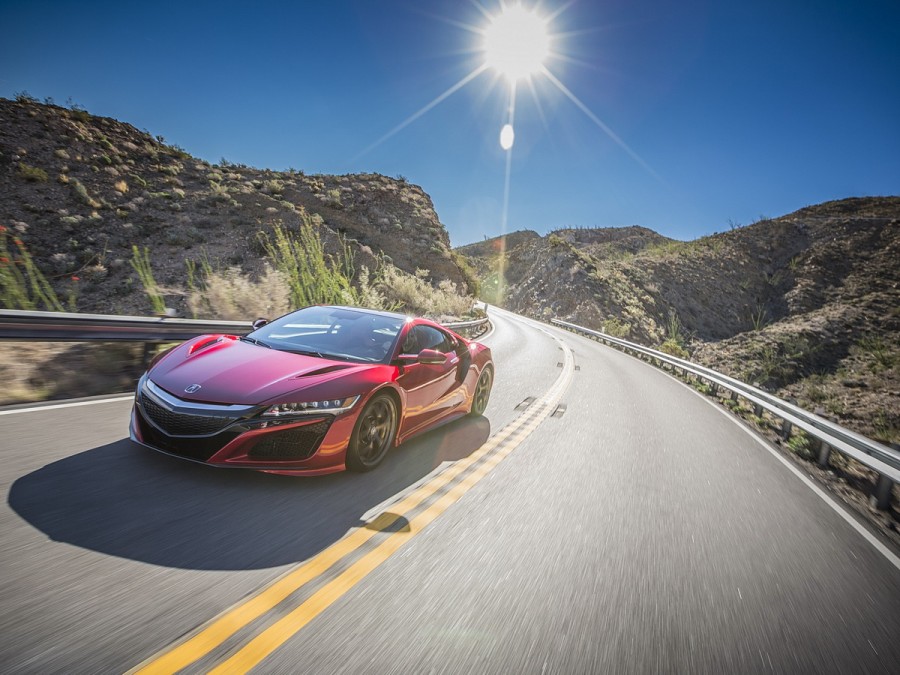
The 2017 Acura NSX is in a word, dramatically drop dead gorgeous. Okay, that’s 4 words, but the car actually warrants more, like futuristic, fantastic, incredible, sexy, and awesome.
The exterior design is a harmonious blend of sharp angles and voluptuous curves while being a case study in function dictating form, with total airflow management as a key element in delivering the level of aerodynamics required for effective and efficient thermal control necessary for the proper operation of its hybrid system. There are 6 different heat sources to be managed: the twin turbo engine, the 9DCT, the PDU, and the 3 electric drive motors. Providing sufficient cooling for these elements, airflow is handled through 10 heat exchangers positioned in the front grille area, side “flying C-pillar” air intakes, as well as through the engine compartment. Getting the air out is just as important as getting the air in, and there are outlets positioned in the upper rear quarter sail panels, beneath the rear spoiler lip and in the lower rear fascia in the form of a large horizontal grille flanked by 2 large vents.
The NSX features 1 of the lowest centers of gravity in its class making ingress and egress somewhat difficult for ectomorphic individuals, but once situated inside, the interior exhibits the same dedicated attention to detail and functionality as the exterior styling. Interior Designer, Johnathon Norman pointed out that controls and switchgear are optimally placed for intuitive use, and the leather sports seats with Alcantara inserts are perfectly contoured and formed to provide excellent support for both boulevard cruising and race track exercises. The steering wheel shape and size feels just right.
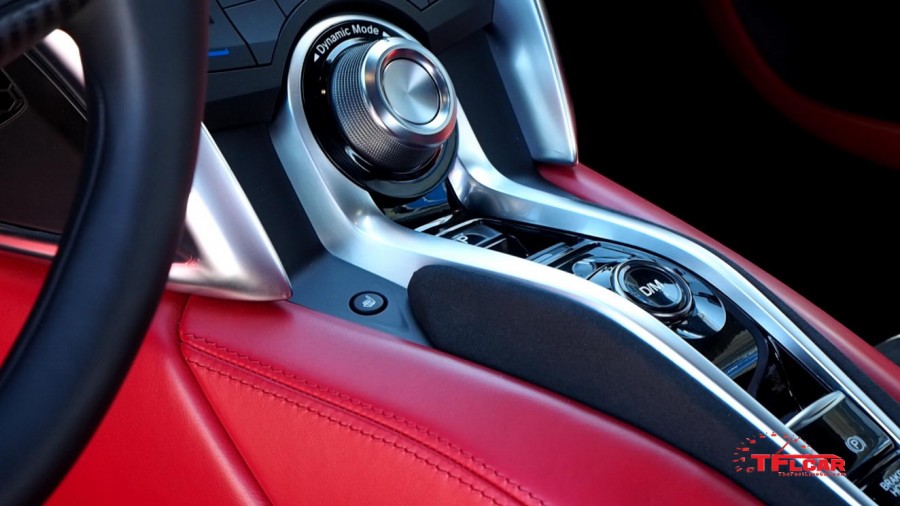
During the media drive program, a group of ten automotive journalists was treated to experiencing the new NSX in both real-world driving scenarios as well as in high-speed race track laps, and launch control demonstrations.
The day began with each journalist donning a helmet and rolling out of pit lane and onto the 1.8-mile, 9 turn course at the exclusive Thermal Club’s West Palm track about 30 minutes out of Palm Springs. Each journalist rotating through 3 cars similarly equipped for 4 laps each in a lead/follow format following none other than noted IndyCar racer Graham Rahal at increasing rates of speed and ultimately reaching a top track speed on the long back straight in excess of 130 mph. The track cars were Venetian Red metallic, Casino White Pearl and Nouvelle Blue metallic, each with a base price of $156,000, and each was outfitted with the carbon ceramic brake system, carbon fiber exterior sport package, carbon fiber roof, carbon fiber engine cover, carbon fiber interior sport package, Acura ELS Studio Audio & Technology Package with Sirius /XM, colored Brembo brake calipers, semi-aniline leather and Alcantara power sport seats, ultra premium “Andaro” paint process and destination charge, bringing the final total before sales tax and license to $200,700.
SUMMARY: The 2017 Acura NSX is performance that is precision crafted. It is incredibly smooth and wickedly fast. Every step of the way, the new NSX does everything that a supercar should, and does everything exceptionally well. On the track, the engineers that developed and perfected the final product served as ride-along instructors with each lap. I was 1 of the 1st out on the track, with Jason Widmer, Principal Engineer and Complete Vehicle Performance Leader riding shotgun; my next ride along companion was Nick Robinson, Lead Engineer, Vehicle Dynamics, followed by pro race driver and instructor Ryan Lewis. Jared Cox, Lead Engineer, Structure and Sound later supervised the Launch Control exercises.
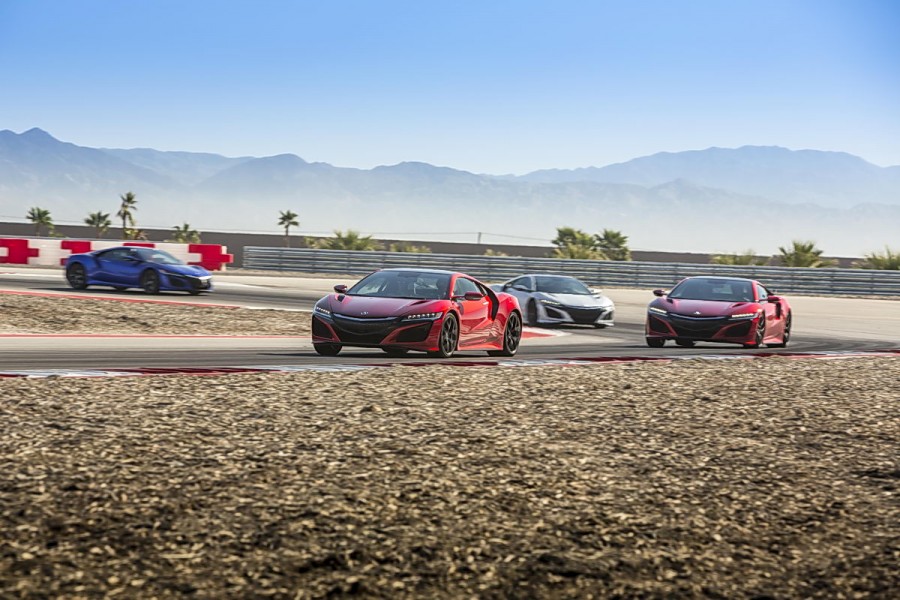
Forward visibility is outstanding thanks to the super thin “A” pillar design while the rear side view is somewhat limited by the large flying “C” pillar. I discovered that the visors are minimally useful depending upon one’s height. Ingress and egress are much easier than with most other supercars. There’s plenty of headroom for those up to 6’5”, even with a helmet on, which can pose some difficulty when entering and exiting the vehicle.
The NSX expands the range of available driving experiences with its Integrated Dynamics System, whose 11 systems provide uniquely tuned experiences for each driving scenario, controlled through a circular knob in the center stack. The left 2 positions are Quiet and Sport, while the right 2 positions are Sport + and Track, which are all pretty self-explanatory. Sport+ provided the most enjoyment for challenging twisty roads, with the Track setting optimizing elevated performance level capabilities. The individual settings also deliver a wide range of tunable sound levels, with a 25dB range between Quiet and Track modes.
Pressing the center button of the IDS dial once places the 9DCT in automatic operation, while pressing it twice enters into manual mode, with control achieved via the wheel-mounted paddle shifters. Even in the automatic mode, it is possible to dive further toward a turn at full speed before braking, and it is possible to apply heavy throttle even before exiting the turn, going almost immediately to full throttle. Overcooking a corner, 1 can feel the car twitch, but it immediately recovers thanks to the AWD system. Braking is phenomenal with the ElectroServo System’s 6-piston Brembo calipers clamping onto the 14.5-inch front ceramic rotors, combined with regenerative braking, and with no indication of fade after hard use. Minimal oversteer may be encountered during trail braking, but again, the AWD comes to the rescue.
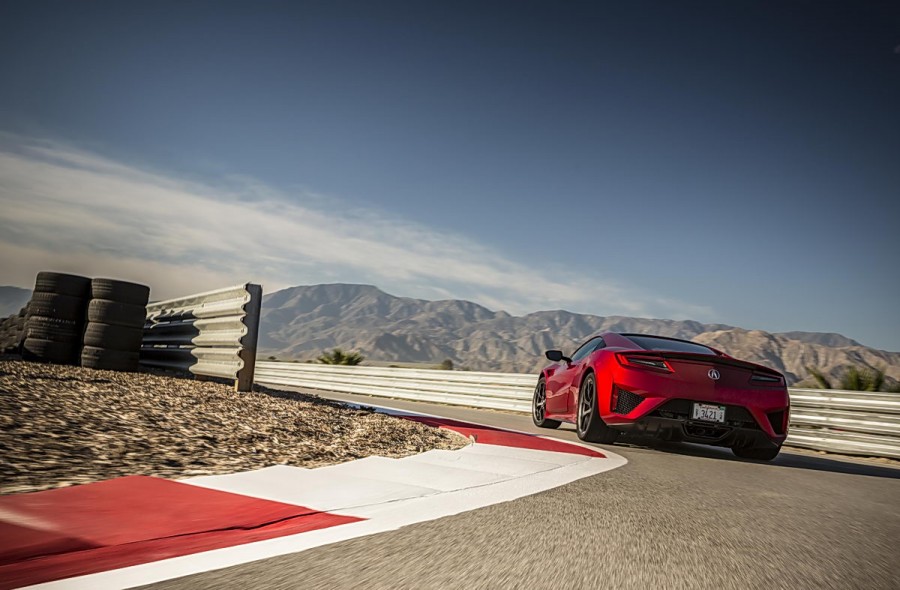
Handling is awesome and you can forget about shuffling hands about on the wheel, as turns are conquered simply by turning with hands in a fixed position. The ride quality is most forgiving with the coilover magnetorheological dampers at each corner – railroad track crossings and bumps in the road are barely noticeable.
The Launch control is the smoothest I’ve encountered to date, with any complicated process or settings to fiddle with. Simply set the IDS to D1, fully depress the brake pedal, mash the accelerator pedal to the floor, and when the IP signal displays the launch ready prompt, release the brake. Keeping the throttle nailed, the NSX takes off like a rocket with no tire slip, ripping down the track while shifting gears at expressly the right moment along the e-ticket ride. There’s no sensation of strain on the running gear, and in fact, the process can be repeated over and over again with no ill effects.
In the final analysis, the Acura team has positively nailed it, for what may well be the perfect supercar, and even at the fully loaded price north of $200,000. I predict an early depletion of the planned production supply. Only 800 are currently slated for the U.S. market, with another 800 for the remaining global market. Jay Leno and Jerry Seinfeld have already placed their orders, so if you want 1, don’t wait too long. The revolutionary 2017 Acura NSX truly delivers the “new sport” experience. All other supercars beware.
On the TFLcar scale of:
Buy it!
Lease it!
Rent it!
… or Forget it!
Lease it!
Rent it!
… or Forget it!

I give the 2017 ACURA a ‘Buy It!‘. If you can afford it, if not, stealing 1 might be an option. It’s an incredible sport hybrid supercar that handles and rides with exceptional precision in virtually any scenario.
PHP Code:
2017 ACURA NSX SPECIFICATIONS:
Base price $156,000
Price as tested $200,700
Powertrain Sport Hybrid SH-AWD Power Unit
Engine 3.5L twin-turbocharged DOHC 24-valve V6
Power
500 @ 6,500-7,500 rpm
Torque
406 @ 2,000 – 6,000 rpm
Direct Drive Motor Permanent magnet water-cooled electric motor/generator
Power
47 hp @ 3,000 rpm
Torque
109 lb-ft @ 500 – 2,000 rpm
Twin Motor Unit (TMU) Permanent magnet, oil-cooled electric motor/generator – independent twin motors in a single package
Horsepower
36 + 36 @ 4,000 rpm
Torque
54 + 54 lb-ft @ 0 – 2,000 rpm
Transmission 9-speed DCT transmission
Drivetrain layout Mid-mounted V6 w/Direct Drive Motor / front-mounted TMU / AWD
Total system output 573 hp, 476 lb-ft torque
Curb weight 3,803 lbs (without options)
Acceleration 0-60 mph 3.4 sec (manufacturer estimate)
EPA-estimated fuel economy 20/22/21 mpg (city/hwy/combined)
Combined range (gas-electric) Approximately 400 miles
Last edited by TSX69; 04-19-2016 at 06:46 AM.
#59
Grandpa
Join Date: Dec 2003
Location: Virginia, Besieged
Age: 68
Posts: 7,596
Received 2,609 Likes
on
1,475 Posts
Ablation casting?
0_o
0_o
#60
Grandpa
Join Date: Dec 2003
Location: Virginia, Besieged
Age: 68
Posts: 7,596
Received 2,609 Likes
on
1,475 Posts
I think we've crossed into the realm of Engineering Gobbledygook.
Ablation
1.
the removal, especially of organs, abnormal growths, or harmful substances, from the body by mechanical means, as by surgery.
2.
the reduction in volume of glacial ice, snow, or névé by the combined processes of melting, evaporation, and calving.
Compare alimentation (def 3).
3.
Aerospace. erosion of the protective outer surface (ablator) of a spacecraft or missile due to the aerodynamic heating caused by travel at hypersonic speed during reentry through the atmosphere.
1.
the removal, especially of organs, abnormal growths, or harmful substances, from the body by mechanical means, as by surgery.
2.
the reduction in volume of glacial ice, snow, or névé by the combined processes of melting, evaporation, and calving.
Compare alimentation (def 3).
3.
Aerospace. erosion of the protective outer surface (ablator) of a spacecraft or missile due to the aerodynamic heating caused by travel at hypersonic speed during reentry through the atmosphere.
#63
I'm afraid we just have to get used to that.
Modern steering wheels aren't even connected to the steering rack, which is amusing. The steering column doesn't go all the way down. It's interrupted part way to the steering rack so that you can drive by wire.
If there's a complete power failure, if the 250-volt battery and the 12-volt battery both fail, then the lack of a signal to the steering column causes a clutch to pop and engage a physical connection that will allow you to steer the car.
Modern steering wheels aren't even connected to the steering rack, which is amusing. The steering column doesn't go all the way down. It's interrupted part way to the steering rack so that you can drive by wire.
If there's a complete power failure, if the 250-volt battery and the 12-volt battery both fail, then the lack of a signal to the steering column causes a clutch to pop and engage a physical connection that will allow you to steer the car.
Here's a good article about electric assist:
Steer Clear: What It Takes to Have Good Steering in an Electric World ? Feature ? Car and Driver | Car and Driver Blog
As for the NSX, I'm hoping for a back-to-basics version that ditches the electric motors and battery, and offers a manual transmission. That would be lighter and cheaper, and would probably offer a more visceral experience. I think it looks fantastic though, and I hope it succeeds in the market.
#64
Safety Car
Thread Starter
2017 Acura NSX Supercar Full Test ? Review ? Car and Driver
- /
- /
- /
- /
2017 Acura NSX
The resurrected NSX previews the hybridized future.
That was more than 5 years ago, and the NSX’s hybrid-electric system is now a fully developed piece of go-faster kit. The car rolling out of Marysville, Ohio, seamlessly combines two turbochargers, three electric motors, 4 driven wheels, 6 cylinders, and nine forward gears to produce bona fide supercar performance. That won’t make it any less controversial; there are an infinite number of ideas as to what a resurrected NSX should have been. The concept that won out is a rolling testbed for the future of performance technology. “You will not find a car in this category in 10 years that won’t have electrification. I’m confident on that,” Widmer says.So are we. The NSX isn’t the 1st of its kind to mesh electrons and hydrocarbons in the pursuit of speed, but give Acura credit for so rapidly democratizing the technology. Even with a starting price of $157,800, the NSX is hard evidence of the kind of trickle-down economics that actually works. Sacrificing a fraction of the performance and the pure-electric driving capability of the 2015 Porsche 918 Spyder netted Acura a $700,000 price cut for its mid-engined hero.Widmer may have been talking about McLarens, Lamborghinis, and Ferraris when he made his 10-year prediction, but the electrification of performance won’t stop at supercars. Defying physics, the electrons are poised to flow into iconic performance cars where there’s even more resistance. Hybridized 911s and BMW M3s are an eventuality, not just a possibility. This NSX is a preview of things to come.
More than any other modern car, the NSX is a product of whichever of its four modes—quiet, sport, sport-plus, and track—is active at the moment. Along with the usual calibration tweaks to the electrically assisted steering, adaptive dampers, and stability-control system, the NSX takes on a different persona depending on how it blends internal combustion and electric thrust.Not That Sporty: Sport Mode
Because there’s nothing “normal” about a 573-hp, torque-vectoring, gas-electric mid-engined Acura, engineers named the NSX’s default street mode “sport.” It strikes us as a misnomer, though, because getting the NSX to accelerate enthusiastically in this mode requires big, deliberate throttle inputs. It’s best suited to urban settings, where the low-end torque of the electric motors—2 up front and a 3rd, larger unit mated to the engine—pulls the NSX off the line faster than traffic, but without spinning the engine much beyond 3000 rpm.
That body is as much a hybrid as is the powertrain. It’s made primarily of aluminum castings, stampings, and extrusions, but the A-pillars, roof beams, and windshield header are all made of steel, meaning there is more ferrous metal in the body of this NSX than in the 27-year-old original. The front floorboards are the only structural carbon-fiber bits, although $21,600 will buy just enough carbon fiber to reskin the roof, engine cover, splitter, sills, diffuser, and spoiler as seen on our $202,960 test car. The outer panels are a mix of formed aluminum and molded plastics.Not That Quiet: Quiet Mode
Compared with the mild-mannered sport mode, quiet mode is the self-effacing, almost apologetic way to pilot a low-slung, Valencia Red Pearl–painted, origami supercar through a crowd; it kills the V-6 whenever possible. It is not, however, a truly silent mode. The engine still fires when you start the car in quiet mode, though it revs only as high as the 1500-rpm fast idle and sounds as fierce as a Honda Odyssey minivan warming its catalysts. Once the powertrain is hot, quiet mode largely behaves like an aggressive stop-start system.If you were expecting to slice through town with the swift, mute moves of a Tesla, you’d be disappointed. With a small lithium-ion battery pack (Acura will only say its capacity is “approximately one kilowatt-hour”) and less than a Honda Civic’s worth of horsepower from the electric motors, the NSX rarely gets above walking speed without firing the engine. It prefers to ride the 3.5-liter V-6 to cruising speed and then sail on electrons up to 50 mph when the road is flat or downhill.
Quiet mode doesn’t soften the suspension or lighten the steering. It’s merely a dimmer switch for the gas engine, shifting more work to the electric motors and exercising the battery harder. The NSX rebuts any attempts to drive hard in this mode. It disables the paddle shifters and causes the transmission to short-shift at 4000 rpm when the accelerator is pegged. And while quiet mode turns down the volume both inside and outside the car by closing the exhaust bypass valves and the intake resonator pipe, it hardly feels tranquil from the driver’s seat. The constant on-off-on of the engine quickly becomes tiresome.Waking Up the NSX: Sport-Plus Mode
The obvious panacea is sport-plus, in which the gas engine never shut off and we never saw the nine-speed transmission shift higher than sixth gear on its own accord. Sport-plus redraws the tachometer to cover 9000 rpm, rather than 8000, but the redline remains unchanged at 7500 rpm, which is also where the boosted V-6 makes its peak 500 horsepower.
The engine’s unusual 75-degree V angle results in a shorter and thus strengthened crankshaft relative to a 60-degree design, and a narrower overall width compared with a 90-degree unit. Forged internals include the crankshaft, connecting rods, and valves. Fuel is injected alternately into either the combustion chambers or the intake ports to maximize both power and efficiency. Yet the engine never sounds nor drives as exotically as it reads on paper.That’s the side effect of performance-enhancing electric motors. They smooth the power delivery to the point that they mask the full contribution of the gas-fed engine. Flatten the accelerator and the NSX stirs the motors, the turbos, and the reciprocating pistons into a cascade of low-end torque, midrange boost, and high-end power. If you could separate the sensation from the intake-resonance tube singing just behind your skull, it would evoke the initial torque swell of an electric vehicle with the seemingly endless pull of a 9000-rpm Porsche. Even during part-throttle shifts, gearchanges register strictly audibly, with the motors masking the momentary blip in gas-engine torque. Our VBOX test equipment, which logs data 100 times per second, failed to detect any slackening in the speed trace when the transmission shifted.
Left in automatic mode in sport-plus, the gearbox will downshift under braking, though not very aggressively. The transmission prefers to keep revs between 3000 and 4000 rpm, and it feels more natural to find the right gear on your own with the paddle shifters. Even then, the transmission often denies the final downshift into 1st gear as you slow for a stop sign, and it’s only as you stomp on the accelerator that you discover the aggravation of still being in second.
Acura resisted the temptation to provide a separate damper calibration for every drive mode, which is fine by us. The Germans often get mired in creating a different but similarly compromised tune for each drive mode. Based on feel alone, Acura’s two settings use a fairly narrow portion of the bandwidth afforded by magnetorheological dampers, with one position covering sport-plus and track modes and a softer tune for quiet and sport.
While the softer position nicely balances ride quality and body control, the stiffer position proved too much on our 10Best loop. The NSX skipped over lumpy sections, the engine revs surging and sagging as the rear tires shifted between light and loaded, which is unsettling busyness that saps confidence. Sport mode’s more compliant damping kept the body planted and allowed a faster pace over the same stretch of road. Unfortunately, there’s no way to decouple the damper settings from the drive mode.Supercar Demeanor, Engaged: Track Mode
In track, the NSX begins to reveal some slightly raw edges and finally begins to feel like what it is—a mid-engined supercar. It’s the rare car that will crash into the rev limiter, rather than automatically upshift during launch-control runs with the trans in manual mode. Track provides a tame launch with a relatively soft clutch engagement from 2500 rpm and no wheelspin, but there’s no mistaking the smeared landscape for anything other than speed. 60 mph arrives in 3.1 seconds, and the quarter-mile requires just 11.2.
Those figures are plenty quick, but the competition seems to challenge Widmer’s assertion that “the reason we have electrification is for performance.” In our August 2016 “Junior Achievement” comparison, the NSX’s rivals—the Audi R8 V-10 Plus, the McLaren 570S, and the Porsche 911 Turbo S—all delivered quicker acceleration without any electric assist. And they did so carrying at least 150 pounds less each.
You can feel the NSX’s urge relaxing near 120 mph as the two 36-hp front motors fade out. Their purpose is more sophisticated than simple straight-line speed, though. The motors do as much to turn the NSX as they do to accelerate the car, and they are never more effective at that task than in track mode. The NSX’s relatively low-torque, front-axle vectoring makes for a decidedly different feeling compared with the rear-axle action we’ve come to know well. A torque-vectoring rear differential, like that found in a Lexus GS F, often provides a tightly controlled drift. In the NSX, the front motors simply pull the car down toward the apex, tightening the trajectory instead of increasing the car’s slip angle. The effect is closer to breathing off the throttle rather than inducing power oversteer.The NSX rarely wants to let its rear tires slip, and with 1.06 g’s of lateral grip from the Trofeo Rs, it rarely wants to slide the front tires, either. The handling balance is practically as harmless as in any Acura sedan, which some might interpret as the ultimate dis from a car magazine. It’s not intended as such here. You want a car that drifts every time you look sideways? Buy a V-8 Chevy Camaro. All-wheel drive and a mid-mounted engine are good at delivering buttoned-up composure. The NSX is no exception.
The NSX’s 70-to-zero stopping distance measures a truncated 142 feet on the $9900 carbon-ceramic brakes. The braking system is essentially a brake-by-wire arrangement with pedal movement translated into electrical signals that are parsed to blend the regenerative braking from the electric motors and the clamping forces of the hydraulic calipers. The pedal is slightly springy when you stand on it, but otherwise it allays the common critique of hybrid brakes: that they are inconsistent and difficult to modulate. Once your foot is recalibrated to the feel, the NSX provides predictable and linear progression every time you go to the left pedal.The hybrid powertrain is the single thin thread tying the NSX to the rest of the Acura showroom. There isn’t a single legitimate sports sedan in the Acura lineup to bathe in the glow of the halo radiating from the NSX, and that seems unlikely to change anytime soon. Instead, Acura can only brag that the electric components are essentially a mirrored reflection of the system used in the RLX Sport Hybrid.
Acura could highlight the NSX’s electric hardware if it would mimic Tesla’s strategy of activating full regen braking when the driver lifts off the throttle, either in the less sporty driving modes or with a standalone, selectable option. 1-pedal driving becomes another connection to the machine, allowing the driver to be an active participant in managing the battery charge and timing accelerator application with greater intention. If we were Acura, we’d consider it.We apparently weren’t too considerate with the right pedal, because we averaged 17 mpg in our time with the NSX, well off the NSX’s 21-mpg EPA combined rating. While the 21-mpg city rating is unmatched by the competition, the 22-mpg highway rating is below that of the 570S and the 911 Turbo S.
The irony of the NSX is that it’s far more impressive for its chassis than for the complex hybrid system that serves as its reason for being. Maybe that’s because the handling really is that good. Or maybe it’s because Acura is still searching for the perfect daily-use driving mode, somewhere between sport-plus and sport. You can be sure that Acura is in a race to perfect its hybrid system with multiple competitors currently prepping similar arrangements. Give it a few more years of development. But let’s hope Acura keeps the chassis the way it is.Competitors
The resurrected NSX previews the hybridized future.
- Oct 2016
- By ERIC TINGWALL
From the November 2016 issue
If a 3868-pound, all-wheel-drive hybrid strikes you as a curious sequel to the original bantamweight NSX, you’re not alone. As vehicle-performance lead engineer Jason Widmer tells it, the initial prospect of a gas-electric NSX caused as much hand-wringing within Honda’s hallways as raised eyebrows outside them. In the early days of the new car, NSX mules consistently laid down faster laps without the battery-electric assist system that was supposed to make the thing quicker.That was more than 5 years ago, and the NSX’s hybrid-electric system is now a fully developed piece of go-faster kit. The car rolling out of Marysville, Ohio, seamlessly combines two turbochargers, three electric motors, 4 driven wheels, 6 cylinders, and nine forward gears to produce bona fide supercar performance. That won’t make it any less controversial; there are an infinite number of ideas as to what a resurrected NSX should have been. The concept that won out is a rolling testbed for the future of performance technology. “You will not find a car in this category in 10 years that won’t have electrification. I’m confident on that,” Widmer says.So are we. The NSX isn’t the 1st of its kind to mesh electrons and hydrocarbons in the pursuit of speed, but give Acura credit for so rapidly democratizing the technology. Even with a starting price of $157,800, the NSX is hard evidence of the kind of trickle-down economics that actually works. Sacrificing a fraction of the performance and the pure-electric driving capability of the 2015 Porsche 918 Spyder netted Acura a $700,000 price cut for its mid-engined hero.Widmer may have been talking about McLarens, Lamborghinis, and Ferraris when he made his 10-year prediction, but the electrification of performance won’t stop at supercars. Defying physics, the electrons are poised to flow into iconic performance cars where there’s even more resistance. Hybridized 911s and BMW M3s are an eventuality, not just a possibility. This NSX is a preview of things to come.
Our test car arrived with $11,860 worth of tire and brake upgrades. The base NSX wears iron brake rotors and less aggressive summer tires.
For Acura, the hybrid system that supplements the 500-hp V-6 plays perfectly to the character of the NSX, both old and new. Just like the original, the modern NSX is every bit as civilized as it is quick. The open sightlines, the wide cabin, and the seats that accommodate the average American are as notable in this class as are the electric motors that give it instant off-the-line thrust. It’s a supercar without a God complex, as unpretentious as a car with an engine behind the driver and a 6-figure price on the window can possibly be.More than any other modern car, the NSX is a product of whichever of its four modes—quiet, sport, sport-plus, and track—is active at the moment. Along with the usual calibration tweaks to the electrically assisted steering, adaptive dampers, and stability-control system, the NSX takes on a different persona depending on how it blends internal combustion and electric thrust.Not That Sporty: Sport Mode
Because there’s nothing “normal” about a 573-hp, torque-vectoring, gas-electric mid-engined Acura, engineers named the NSX’s default street mode “sport.” It strikes us as a misnomer, though, because getting the NSX to accelerate enthusiastically in this mode requires big, deliberate throttle inputs. It’s best suited to urban settings, where the low-end torque of the electric motors—2 up front and a 3rd, larger unit mated to the engine—pulls the NSX off the line faster than traffic, but without spinning the engine much beyond 3000 rpm.
The engine-cover designer apparently grew up loving Jiffy Pop. The stiffer of the two suspension settings is a bit much for public-road driving.
The chassis is always awake even if the powertrain isn’t. With $1960 worth of Pirelli P Zero Trofeo R tires gluing the wheels to the pavement, our test car faithfully transmitted every minute steering input to the road regardless of the mode. Even as the steering weight ramps up with the more aggressive settings, the NSX turns in with zeal and precision. Most impressive, the NSX never belies its weight, no matter how fast the speed or how sharp the corner. Turns feel effortless, and as long as the pavement is smooth, the body remains flat.That body is as much a hybrid as is the powertrain. It’s made primarily of aluminum castings, stampings, and extrusions, but the A-pillars, roof beams, and windshield header are all made of steel, meaning there is more ferrous metal in the body of this NSX than in the 27-year-old original. The front floorboards are the only structural carbon-fiber bits, although $21,600 will buy just enough carbon fiber to reskin the roof, engine cover, splitter, sills, diffuser, and spoiler as seen on our $202,960 test car. The outer panels are a mix of formed aluminum and molded plastics.Not That Quiet: Quiet Mode
Compared with the mild-mannered sport mode, quiet mode is the self-effacing, almost apologetic way to pilot a low-slung, Valencia Red Pearl–painted, origami supercar through a crowd; it kills the V-6 whenever possible. It is not, however, a truly silent mode. The engine still fires when you start the car in quiet mode, though it revs only as high as the 1500-rpm fast idle and sounds as fierce as a Honda Odyssey minivan warming its catalysts. Once the powertrain is hot, quiet mode largely behaves like an aggressive stop-start system.If you were expecting to slice through town with the swift, mute moves of a Tesla, you’d be disappointed. With a small lithium-ion battery pack (Acura will only say its capacity is “approximately one kilowatt-hour”) and less than a Honda Civic’s worth of horsepower from the electric motors, the NSX rarely gets above walking speed without firing the engine. It prefers to ride the 3.5-liter V-6 to cruising speed and then sail on electrons up to 50 mph when the road is flat or downhill.
Quiet mode doesn’t soften the suspension or lighten the steering. It’s merely a dimmer switch for the gas engine, shifting more work to the electric motors and exercising the battery harder. The NSX rebuts any attempts to drive hard in this mode. It disables the paddle shifters and causes the transmission to short-shift at 4000 rpm when the accelerator is pegged. And while quiet mode turns down the volume both inside and outside the car by closing the exhaust bypass valves and the intake resonator pipe, it hardly feels tranquil from the driver’s seat. The constant on-off-on of the engine quickly becomes tiresome.Waking Up the NSX: Sport-Plus Mode
The obvious panacea is sport-plus, in which the gas engine never shut off and we never saw the nine-speed transmission shift higher than sixth gear on its own accord. Sport-plus redraws the tachometer to cover 9000 rpm, rather than 8000, but the redline remains unchanged at 7500 rpm, which is also where the boosted V-6 makes its peak 500 horsepower.
The engine’s unusual 75-degree V angle results in a shorter and thus strengthened crankshaft relative to a 60-degree design, and a narrower overall width compared with a 90-degree unit. Forged internals include the crankshaft, connecting rods, and valves. Fuel is injected alternately into either the combustion chambers or the intake ports to maximize both power and efficiency. Yet the engine never sounds nor drives as exotically as it reads on paper.That’s the side effect of performance-enhancing electric motors. They smooth the power delivery to the point that they mask the full contribution of the gas-fed engine. Flatten the accelerator and the NSX stirs the motors, the turbos, and the reciprocating pistons into a cascade of low-end torque, midrange boost, and high-end power. If you could separate the sensation from the intake-resonance tube singing just behind your skull, it would evoke the initial torque swell of an electric vehicle with the seemingly endless pull of a 9000-rpm Porsche. Even during part-throttle shifts, gearchanges register strictly audibly, with the motors masking the momentary blip in gas-engine torque. Our VBOX test equipment, which logs data 100 times per second, failed to detect any slackening in the speed trace when the transmission shifted.
Left in automatic mode in sport-plus, the gearbox will downshift under braking, though not very aggressively. The transmission prefers to keep revs between 3000 and 4000 rpm, and it feels more natural to find the right gear on your own with the paddle shifters. Even then, the transmission often denies the final downshift into 1st gear as you slow for a stop sign, and it’s only as you stomp on the accelerator that you discover the aggravation of still being in second.
Acura resisted the temptation to provide a separate damper calibration for every drive mode, which is fine by us. The Germans often get mired in creating a different but similarly compromised tune for each drive mode. Based on feel alone, Acura’s two settings use a fairly narrow portion of the bandwidth afforded by magnetorheological dampers, with one position covering sport-plus and track modes and a softer tune for quiet and sport.
While the softer position nicely balances ride quality and body control, the stiffer position proved too much on our 10Best loop. The NSX skipped over lumpy sections, the engine revs surging and sagging as the rear tires shifted between light and loaded, which is unsettling busyness that saps confidence. Sport mode’s more compliant damping kept the body planted and allowed a faster pace over the same stretch of road. Unfortunately, there’s no way to decouple the damper settings from the drive mode.Supercar Demeanor, Engaged: Track Mode
In track, the NSX begins to reveal some slightly raw edges and finally begins to feel like what it is—a mid-engined supercar. It’s the rare car that will crash into the rev limiter, rather than automatically upshift during launch-control runs with the trans in manual mode. Track provides a tame launch with a relatively soft clutch engagement from 2500 rpm and no wheelspin, but there’s no mistaking the smeared landscape for anything other than speed. 60 mph arrives in 3.1 seconds, and the quarter-mile requires just 11.2.
Those figures are plenty quick, but the competition seems to challenge Widmer’s assertion that “the reason we have electrification is for performance.” In our August 2016 “Junior Achievement” comparison, the NSX’s rivals—the Audi R8 V-10 Plus, the McLaren 570S, and the Porsche 911 Turbo S—all delivered quicker acceleration without any electric assist. And they did so carrying at least 150 pounds less each.
You can feel the NSX’s urge relaxing near 120 mph as the two 36-hp front motors fade out. Their purpose is more sophisticated than simple straight-line speed, though. The motors do as much to turn the NSX as they do to accelerate the car, and they are never more effective at that task than in track mode. The NSX’s relatively low-torque, front-axle vectoring makes for a decidedly different feeling compared with the rear-axle action we’ve come to know well. A torque-vectoring rear differential, like that found in a Lexus GS F, often provides a tightly controlled drift. In the NSX, the front motors simply pull the car down toward the apex, tightening the trajectory instead of increasing the car’s slip angle. The effect is closer to breathing off the throttle rather than inducing power oversteer.The NSX rarely wants to let its rear tires slip, and with 1.06 g’s of lateral grip from the Trofeo Rs, it rarely wants to slide the front tires, either. The handling balance is practically as harmless as in any Acura sedan, which some might interpret as the ultimate dis from a car magazine. It’s not intended as such here. You want a car that drifts every time you look sideways? Buy a V-8 Chevy Camaro. All-wheel drive and a mid-mounted engine are good at delivering buttoned-up composure. The NSX is no exception.
The NSX’s 70-to-zero stopping distance measures a truncated 142 feet on the $9900 carbon-ceramic brakes. The braking system is essentially a brake-by-wire arrangement with pedal movement translated into electrical signals that are parsed to blend the regenerative braking from the electric motors and the clamping forces of the hydraulic calipers. The pedal is slightly springy when you stand on it, but otherwise it allays the common critique of hybrid brakes: that they are inconsistent and difficult to modulate. Once your foot is recalibrated to the feel, the NSX provides predictable and linear progression every time you go to the left pedal.The hybrid powertrain is the single thin thread tying the NSX to the rest of the Acura showroom. There isn’t a single legitimate sports sedan in the Acura lineup to bathe in the glow of the halo radiating from the NSX, and that seems unlikely to change anytime soon. Instead, Acura can only brag that the electric components are essentially a mirrored reflection of the system used in the RLX Sport Hybrid.
Acura could highlight the NSX’s electric hardware if it would mimic Tesla’s strategy of activating full regen braking when the driver lifts off the throttle, either in the less sporty driving modes or with a standalone, selectable option. 1-pedal driving becomes another connection to the machine, allowing the driver to be an active participant in managing the battery charge and timing accelerator application with greater intention. If we were Acura, we’d consider it.We apparently weren’t too considerate with the right pedal, because we averaged 17 mpg in our time with the NSX, well off the NSX’s 21-mpg EPA combined rating. While the 21-mpg city rating is unmatched by the competition, the 22-mpg highway rating is below that of the 570S and the 911 Turbo S.
The irony of the NSX is that it’s far more impressive for its chassis than for the complex hybrid system that serves as its reason for being. Maybe that’s because the handling really is that good. Or maybe it’s because Acura is still searching for the perfect daily-use driving mode, somewhere between sport-plus and sport. You can be sure that Acura is in a race to perfect its hybrid system with multiple competitors currently prepping similar arrangements. Give it a few more years of development. But let’s hope Acura keeps the chassis the way it is.Competitors
#65
Safety Car
Thread Starter
The 2017 NSX Isn't Just the Fastest Acura Ever, It Might Be the Most Fun
 Photo: Dan CarneyWhen the Pixar Animation family classic Toy Story was in development, then-owner Steve Jobs halted the production, ordering a rewrite to make the Woody character more likable. Such a dramatic change, so late in a film's production usually bodes ill for the final result, but it turned out to be just what Woody and Buzz needed to become new fixtures in the American childscape.
Photo: Dan CarneyWhen the Pixar Animation family classic Toy Story was in development, then-owner Steve Jobs halted the production, ordering a rewrite to make the Woody character more likable. Such a dramatic change, so late in a film's production usually bodes ill for the final result, but it turned out to be just what Woody and Buzz needed to become new fixtures in the American childscape. Photo: AcuraSimilarly, only about 2 years ago, Acura concluded that its NSX design was unacceptably compromised and ordered a major revision. As with Toy Story, this change further delayed a project that was already behind schedule.
Photo: AcuraSimilarly, only about 2 years ago, Acura concluded that its NSX design was unacceptably compromised and ordered a major revision. As with Toy Story, this change further delayed a project that was already behind schedule. Photo: AcuraIt is too soon to know whether the 2017 Acura NSX will ever establish a reputation as sterling as that of Toy Story, but we do know that the decision to change the orientation of the engine in the chassis has produced exactly the sort of track-worthy machine buyers in this category demand. For starters, it's the fastest Acura ever with a 191 MPH top speed, and can scorch from 0-60 in just 3 seconds flat.
Photo: AcuraIt is too soon to know whether the 2017 Acura NSX will ever establish a reputation as sterling as that of Toy Story, but we do know that the decision to change the orientation of the engine in the chassis has produced exactly the sort of track-worthy machine buyers in this category demand. For starters, it's the fastest Acura ever with a 191 MPH top speed, and can scorch from 0-60 in just 3 seconds flat.  Photo: Dan CarneyThe car's significantly racy design change was to turn the engine 90 degrees so that it is placed in alignment with the car's spine (like a race car) rather than sideways between the rear wheels (as with most street cars these days).
Photo: Dan CarneyThe car's significantly racy design change was to turn the engine 90 degrees so that it is placed in alignment with the car's spine (like a race car) rather than sideways between the rear wheels (as with most street cars these days).  Photo: AcuraThis pushed those rear wheels a few inches further rearward and shifted the NSX's weight balance slightly forward, producing exactly the race-worthy handling expected from such a car. The original 1991-2005 NSX employed a transverse engine layout successfully, but with 290 horsepower, it had far less power to put to the ground and did so at lower speeds.
Photo: AcuraThis pushed those rear wheels a few inches further rearward and shifted the NSX's weight balance slightly forward, producing exactly the race-worthy handling expected from such a car. The original 1991-2005 NSX employed a transverse engine layout successfully, but with 290 horsepower, it had far less power to put to the ground and did so at lower speeds. Photo: Dan CarneyThe 2017 NSX's 3.5-liter V6 is twin-turbocharged, which pumps it up to 500 horsepower, and gets a 119-horsepower assist from a trio of electric motors. 1 electric motor is bolted to the gas engine and helps drive the rear wheels, and the other 2 are at the front of the car, providing power to the front wheels.
Photo: Dan CarneyThe 2017 NSX's 3.5-liter V6 is twin-turbocharged, which pumps it up to 500 horsepower, and gets a 119-horsepower assist from a trio of electric motors. 1 electric motor is bolted to the gas engine and helps drive the rear wheels, and the other 2 are at the front of the car, providing power to the front wheels. Photo: AcuraTotal system power is 573 peak horsepower, because, as with the romantic capacities of men and women, the gas engine and the electric motors hit their peaks at different times.
Photo: AcuraTotal system power is 573 peak horsepower, because, as with the romantic capacities of men and women, the gas engine and the electric motors hit their peaks at different times. Photo: AcuraThe engine peaks out through the window in the rear cover, revealing Y-shaped intake plumbing that lacks some fiber optic lighting to resemble a time-traveling flux capacitor. Its attached electric motor starts the gas engine none of the uncouth whining of a conventional starter, but rather with a "Vrroom!" that creates the impression that the engine had been running all along and just decided to speak up.
Photo: AcuraThe engine peaks out through the window in the rear cover, revealing Y-shaped intake plumbing that lacks some fiber optic lighting to resemble a time-traveling flux capacitor. Its attached electric motor starts the gas engine none of the uncouth whining of a conventional starter, but rather with a "Vrroom!" that creates the impression that the engine had been running all along and just decided to speak up. Photo: Dan CarneyThe car has 4 operating modes; "quiet," "sport," "sport+" and "track." Each of these tweaks the electronic adjustments of the magnetically variable shock absorbers, the 9-speed automatic transmission, the electric power steering, the all-wheel-drive system, the electronic stability control system and active muffler bypass valves.
Photo: Dan CarneyThe car has 4 operating modes; "quiet," "sport," "sport+" and "track." Each of these tweaks the electronic adjustments of the magnetically variable shock absorbers, the 9-speed automatic transmission, the electric power steering, the all-wheel-drive system, the electronic stability control system and active muffler bypass valves. Photo: AcuraAn unprecedented range of adjustability in each of these areas permits the NSX to have the most dramatic personality changes since Brad and Janet met Dr. Frank-N-Furter. In Quiet mode, the NSX is as buttoned up as the young couple was upon arrival to the doctor's mansion, and in Race mode, the NSX goes for full-on debauchery.
Photo: AcuraAn unprecedented range of adjustability in each of these areas permits the NSX to have the most dramatic personality changes since Brad and Janet met Dr. Frank-N-Furter. In Quiet mode, the NSX is as buttoned up as the young couple was upon arrival to the doctor's mansion, and in Race mode, the NSX goes for full-on debauchery. Photo: Dan CarneyFor younger drivers seeking a primer on the meaning of the term "understeer," (which is when the front wheels are turned toward a curve but they slide so the car continues straight), the NSX is wonderfully instructive. The car begins in Quiet mode with abundant, safe understeer, which keeps the car from spinning around, and then lessens the understeer progressively in each mode up through "Track," where the NSX is largely neutral.
Photo: Dan CarneyFor younger drivers seeking a primer on the meaning of the term "understeer," (which is when the front wheels are turned toward a curve but they slide so the car continues straight), the NSX is wonderfully instructive. The car begins in Quiet mode with abundant, safe understeer, which keeps the car from spinning around, and then lessens the understeer progressively in each mode up through "Track," where the NSX is largely neutral. Photo: Dan CarneyThe car's exhaust volume also ratchets upward through the settings, and the great thing is that the driver can decide when to engage in which. So unlike too many of its competitors which force the driver to look like a preening rooster on trips to Walgreens, the NSX can creep surreptitiously out of the neighborhood in the wee hours, but still announce its presence with suitable authority at the track.
Photo: Dan CarneyThe car's exhaust volume also ratchets upward through the settings, and the great thing is that the driver can decide when to engage in which. So unlike too many of its competitors which force the driver to look like a preening rooster on trips to Walgreens, the NSX can creep surreptitiously out of the neighborhood in the wee hours, but still announce its presence with suitable authority at the track. Photo: AcuraIt would be nice to be able to employ track mode without disabling the stability control system, for some noisy fun that preserves the car's electronic safety net.
Photo: AcuraIt would be nice to be able to employ track mode without disabling the stability control system, for some noisy fun that preserves the car's electronic safety net.
An iffier electronic feature of the NSX is electric servo-operated brakes that disconnect the brake pedal from the actual brakes. In earlier, failed attempts to introduce this technology, other automakers have tolerated an utter absence of brake feel needed to communicate whether the car is responding as expected.
The NSX's electric brakes are better than that. Indeed, at high speeds they provide a feeling of imperturbable confidence, which may or may not be warranted. Even at trickier lower speeds, when the car has less inertia and is more vulnerable to misapplications of brake pressure, the system still holds up well compared to conventional brakes. But at very low parking speeds, stopping the car can still be abrupt. The feeling is similar to that provided by some carbon ceramic brakes, which can be difficult to modulate at walking speeds.
And the test NSX was fact equipped with such brakes. But with their electronic operation, there was no possibility of feeling what the carbon brakes were doing, so any misunderstandings were an artifact of the electronics and not the ceramic brake rotors' characteristics.
Our test car featured the optional $6,000 Valencia Red Pearl paint that could be considered mandatory because of its incredible appearance. The hue gives the NSX a sophistication that a mid-engined supercar could lack if improperly executed.
Photo: Dan Carney
Similarly, the NSX's exuberant lines attracted compliments everywhere the car went, typically followed by the exclamation, "That's an Acura?!" Yes indeed it is.
It was reassuring to hear Acura's big bet garnering such favorable comments, because after seeing the car only in the unreal world of the auto show circuit where the NSX competes for notice with Ford's astounding new GT and various garishly finished Italian, German and English supercars, the NSX's ability to stand up for itself was uncertain.
The adjustable suspension provides a surprisingly cushy ride and even the racing-style seats are acceptably comfy for highway cruising. Legroom for occupants' door-side legs is always in short supply in mid-engined sports cars, but the NSX does a good enough job in this respect to prevent leg cramps on long drives.
The other thing that will prevent leg cramps is the frequent opportunity to get out and walk around while the NSX is refueling. The car's EPA numbers are unremarkable, at 20 mpg city and 22 mpg highway. But the raison d'etre of the hybrid system is to boost efficiency, and the NSX falls well short on the highway of cars like the Corvette, which gets 29 mpg on the highway.
Further, in 150 miles of test driving, which included a few laps around a racetrack, but which was mostly highway driving to and from that track, the NSX returned 14.75 mpg, putting it in company with the V10 Dodge Viper. At that rate, strolls around the gas pumps will keep NSX occupants' legs stretched.
Acura's goal for the NSX is to cultivate a more prestigious image for the brand that has too often relied on selling dressed-up Hondas, and the car achieves its technical objectives. With a $209,500 as-tested price, the cost alone will push Acura into unprecedented demographics.
A true conversion of the Acura brand into an authentic prestige brand would be a personality transplant on par with Pixar's conversion of Woody from unsympathetically jealous to affable Tom Hanks good guy.
 Photo: Dan Carney
Photo: Dan Carney Photo: Acura
Photo: Acura Photo: Acura
Photo: Acura Photo: Dan Carney
Photo: Dan Carney Photo: Acura
Photo: Acura Photo: Dan Carney
Photo: Dan Carney Photo: Acura
Photo: Acura Photo: Acura
Photo: Acura Photo: Dan Carney
Photo: Dan Carney Photo: Acura
Photo: Acura Photo: Dan Carney
Photo: Dan Carney Photo: Dan Carney
Photo: Dan Carney Photo: Acura
Photo: AcuraAn iffier electronic feature of the NSX is electric servo-operated brakes that disconnect the brake pedal from the actual brakes. In earlier, failed attempts to introduce this technology, other automakers have tolerated an utter absence of brake feel needed to communicate whether the car is responding as expected.
The NSX's electric brakes are better than that. Indeed, at high speeds they provide a feeling of imperturbable confidence, which may or may not be warranted. Even at trickier lower speeds, when the car has less inertia and is more vulnerable to misapplications of brake pressure, the system still holds up well compared to conventional brakes. But at very low parking speeds, stopping the car can still be abrupt. The feeling is similar to that provided by some carbon ceramic brakes, which can be difficult to modulate at walking speeds.
And the test NSX was fact equipped with such brakes. But with their electronic operation, there was no possibility of feeling what the carbon brakes were doing, so any misunderstandings were an artifact of the electronics and not the ceramic brake rotors' characteristics.
Our test car featured the optional $6,000 Valencia Red Pearl paint that could be considered mandatory because of its incredible appearance. The hue gives the NSX a sophistication that a mid-engined supercar could lack if improperly executed.

Photo: Dan Carney
Similarly, the NSX's exuberant lines attracted compliments everywhere the car went, typically followed by the exclamation, "That's an Acura?!" Yes indeed it is.
It was reassuring to hear Acura's big bet garnering such favorable comments, because after seeing the car only in the unreal world of the auto show circuit where the NSX competes for notice with Ford's astounding new GT and various garishly finished Italian, German and English supercars, the NSX's ability to stand up for itself was uncertain.
The adjustable suspension provides a surprisingly cushy ride and even the racing-style seats are acceptably comfy for highway cruising. Legroom for occupants' door-side legs is always in short supply in mid-engined sports cars, but the NSX does a good enough job in this respect to prevent leg cramps on long drives.
The other thing that will prevent leg cramps is the frequent opportunity to get out and walk around while the NSX is refueling. The car's EPA numbers are unremarkable, at 20 mpg city and 22 mpg highway. But the raison d'etre of the hybrid system is to boost efficiency, and the NSX falls well short on the highway of cars like the Corvette, which gets 29 mpg on the highway.
Further, in 150 miles of test driving, which included a few laps around a racetrack, but which was mostly highway driving to and from that track, the NSX returned 14.75 mpg, putting it in company with the V10 Dodge Viper. At that rate, strolls around the gas pumps will keep NSX occupants' legs stretched.
Acura's goal for the NSX is to cultivate a more prestigious image for the brand that has too often relied on selling dressed-up Hondas, and the car achieves its technical objectives. With a $209,500 as-tested price, the cost alone will push Acura into unprecedented demographics.
A true conversion of the Acura brand into an authentic prestige brand would be a personality transplant on par with Pixar's conversion of Woody from unsympathetically jealous to affable Tom Hanks good guy.
#66
Senior Moderator
testdrivenow.com
#67
You'll Never Walk Alone
iTrader: (1)
Join Date: Jun 2005
Location: Vancouver, BC, Canada
Age: 37
Posts: 9,492
Received 834 Likes
on
518 Posts
Road and Track just crowned the NSX the Performance Car of the Year against the likes of Corvette Grand Sport, Nismo GT-R, R8 V10+, and 911 Turbo S:
2017 Best Performance Car of the Year - 2017 Acura NSX Named Road & Track's PCOTY
It was a pretty solid win too, winning 8 votes out of 10.
2017 Best Performance Car of the Year - 2017 Acura NSX Named Road & Track's PCOTY
It was a pretty solid win too, winning 8 votes out of 10.
#68
Senior Moderator
Vehicle Virgins
"Not two thumbs up, not thumbs down, it is...it's an NSX."
#69
Senior Moderator
Vehicle Virgins: 5 thing I hate about the '17 Acura NSX
#70
Senior Moderator
Seen Through Glass: Why Does No One Care About the NSX?
A largely positive review.
#71
Senior Moderator
Edmunds: 2017 Acura NSX | Track Test: How Fast Is It?
tl:dr: 3.19s 0-60 with launch control on, 11.18 1/4-mile
#72
Senior Moderator
Motoring Australia: NSX vs. GT-R Nismo
NSX wins for daily use, GT-R for track use.
#73
Senior Moderator
NHK: Samurai Wheels, NSX test drive and review
In English/English dubbing.
#74
Senior Moderator
Driven Car Reviews
#75
Senior Moderator
Engineering Explained
Yeah, it's basically an ad to support his channel, but here's his video anyway..
Thread
Thread Starter
Forum
Replies
Last Post
rockyboy
2G RDX (2013-2018)
46
01-25-2016 06:00 PM
Skirmich
2G TL (1999-2003)
37
09-15-2015 06:41 PM
ostrich
5G TLX (2015-2020)
7
09-11-2015 04:28 PM
asahrts
Member Cars for Sale
0
09-04-2015 05:55 PM


